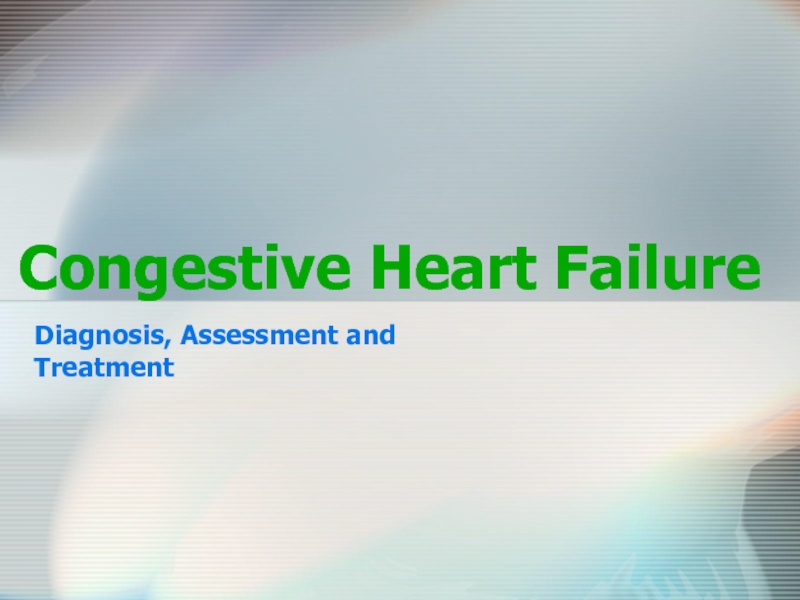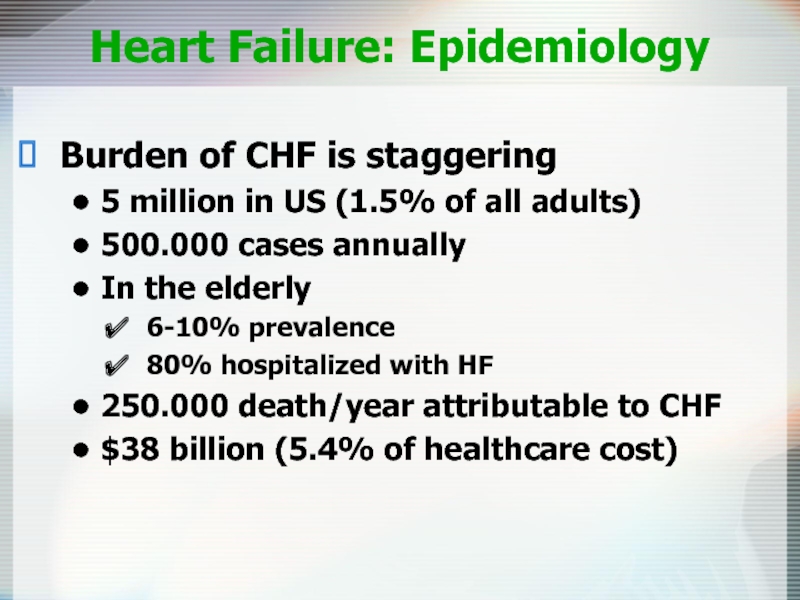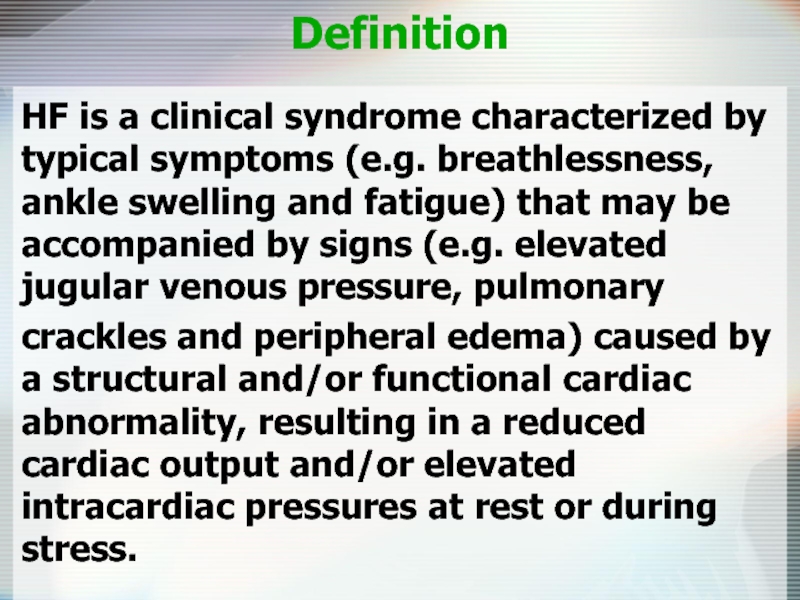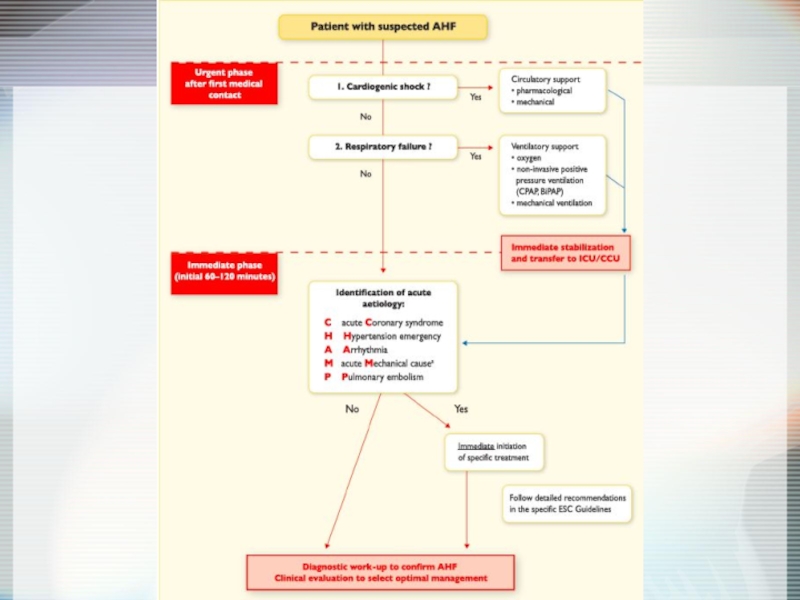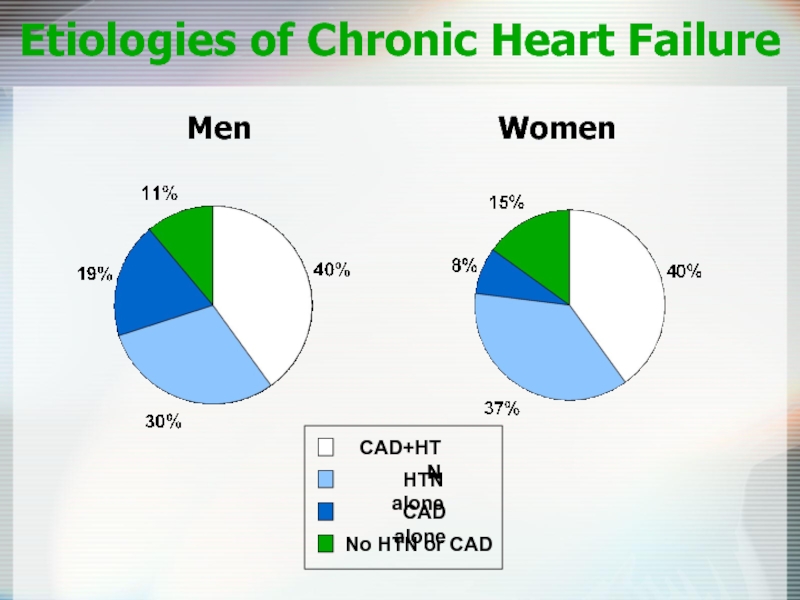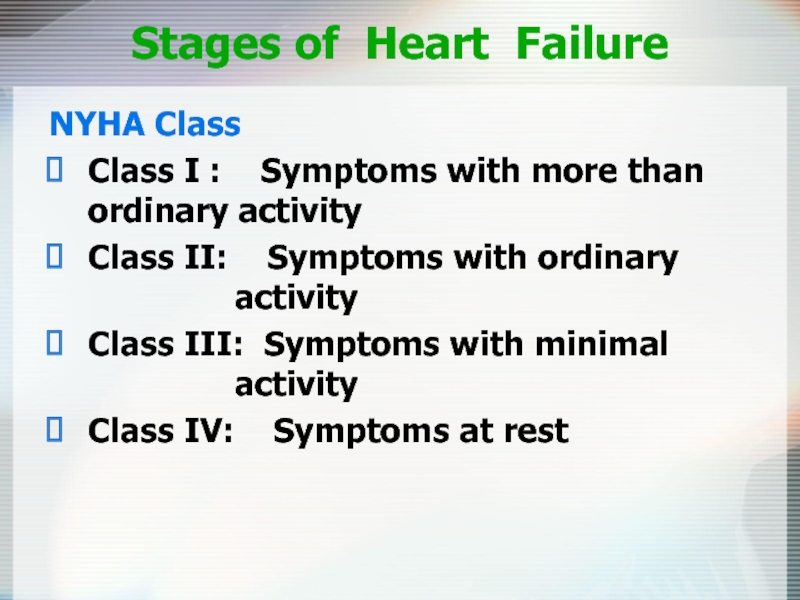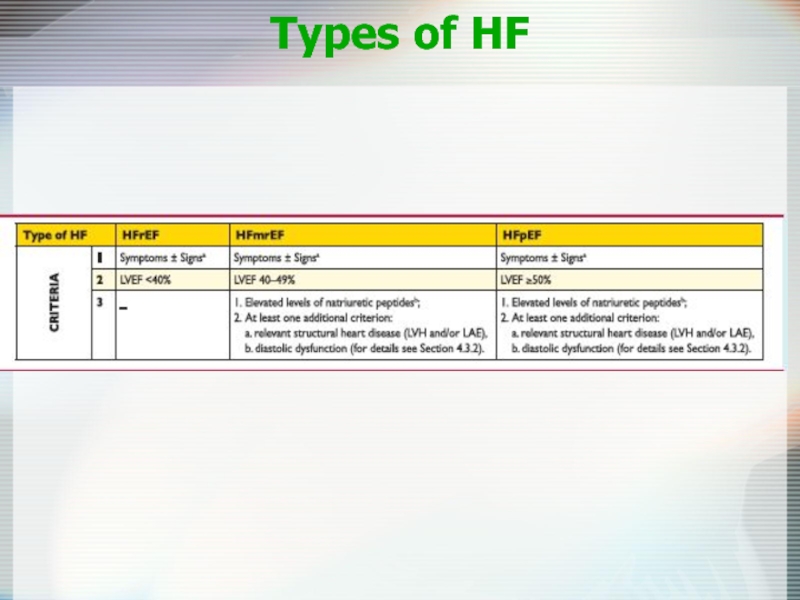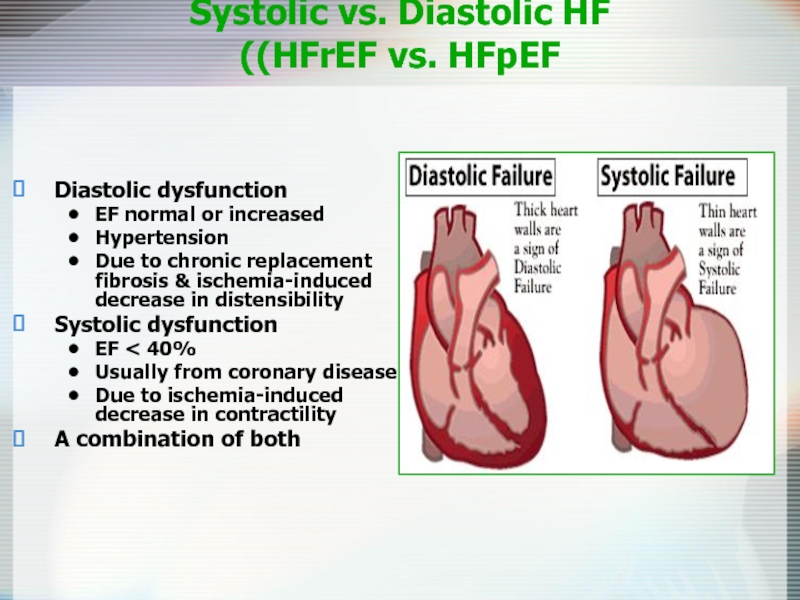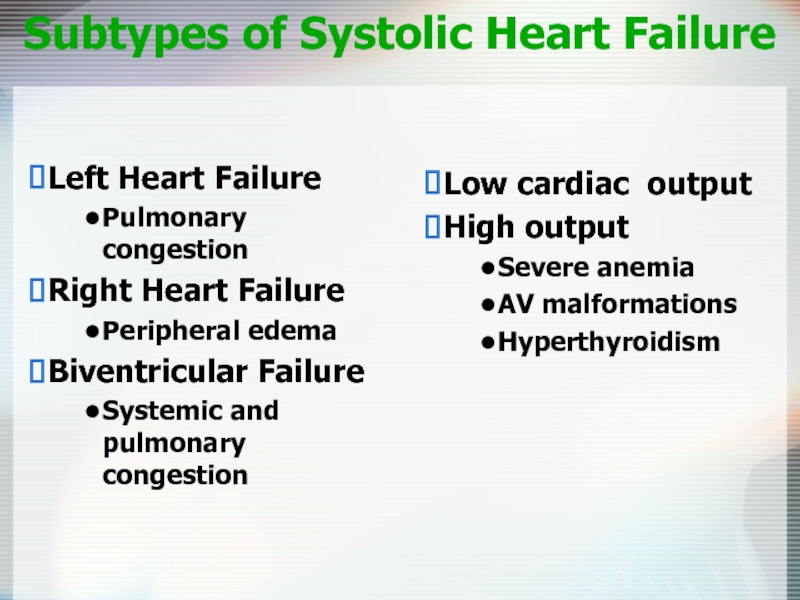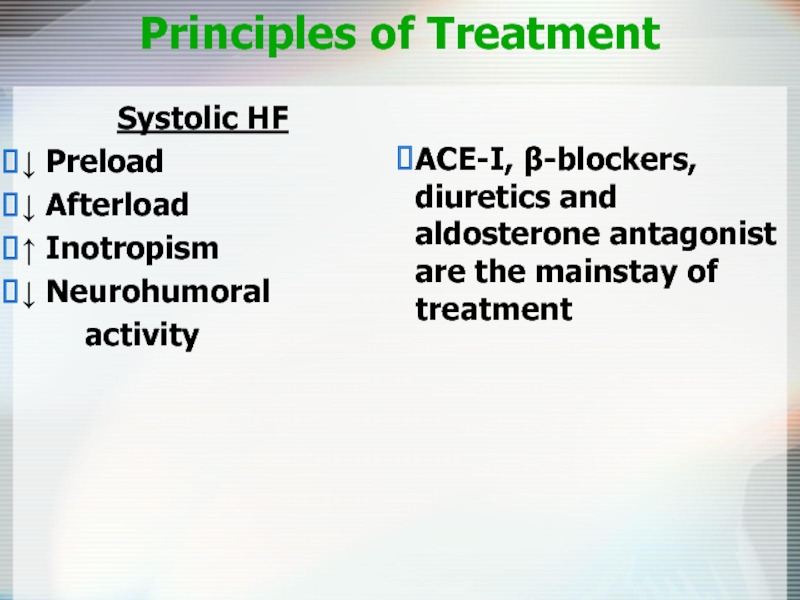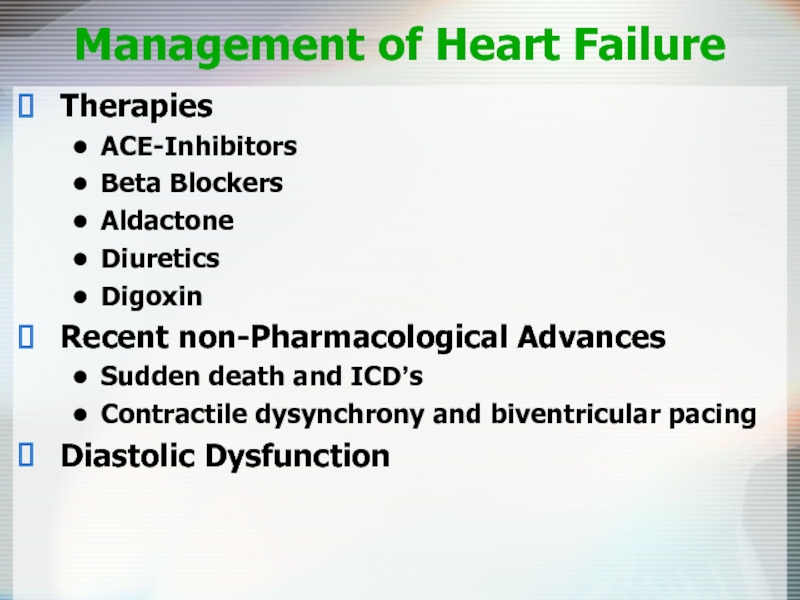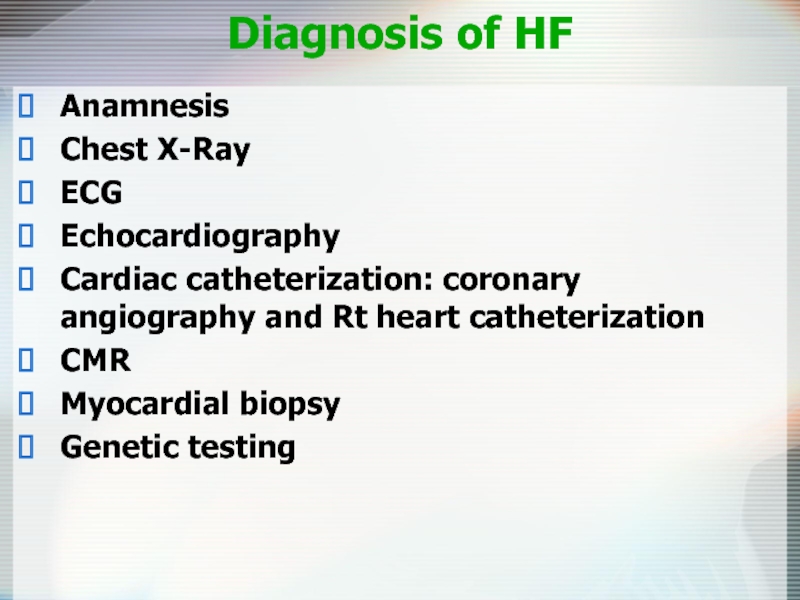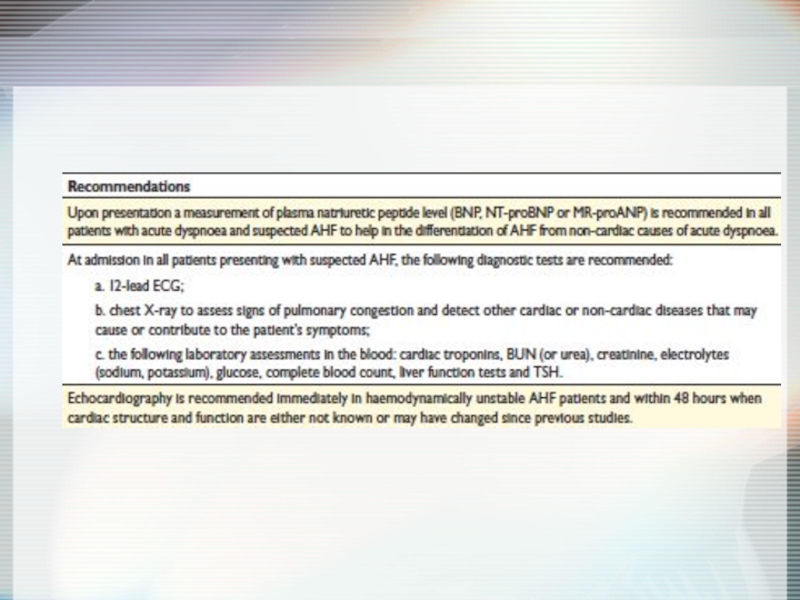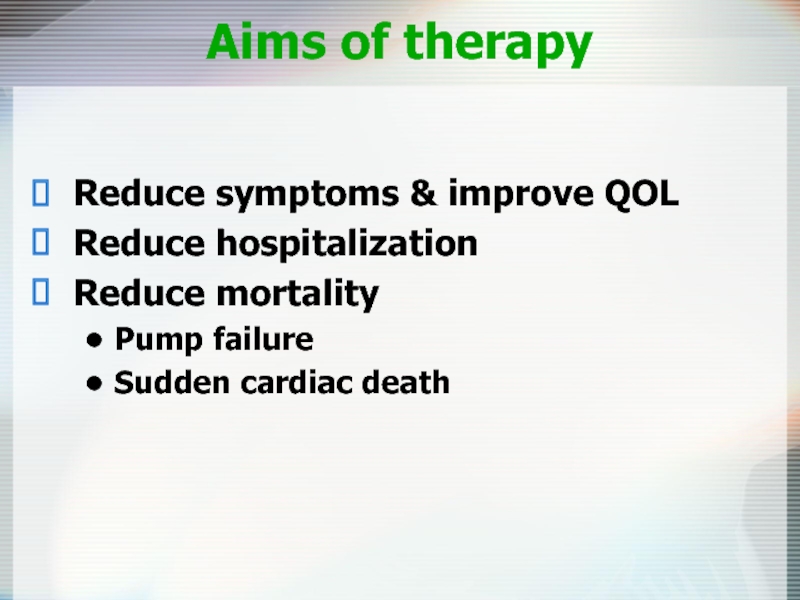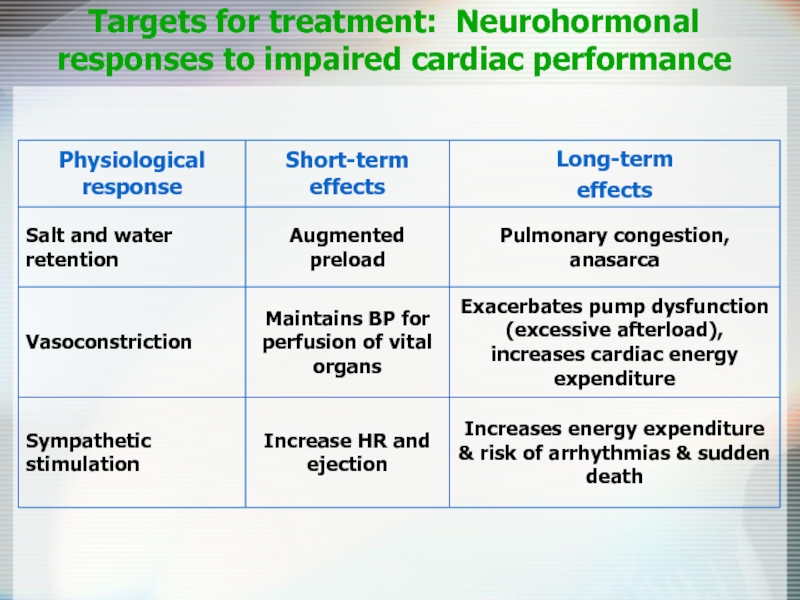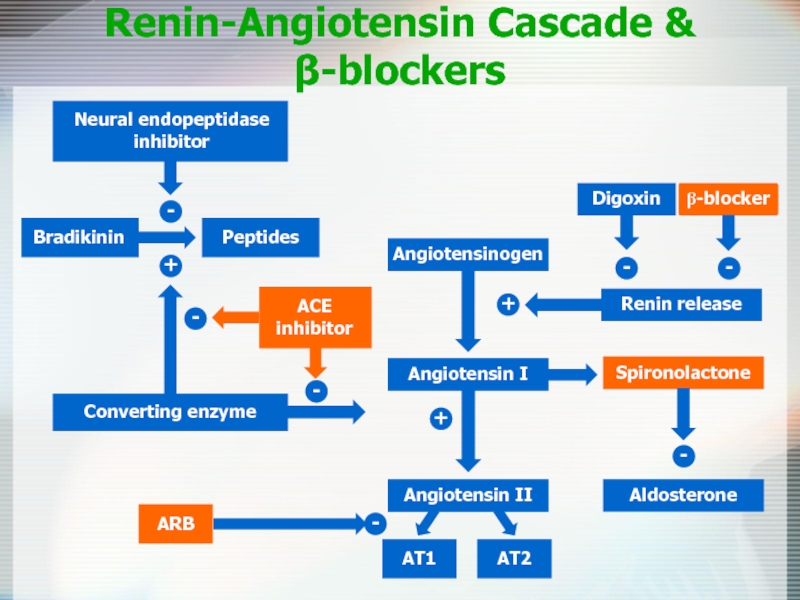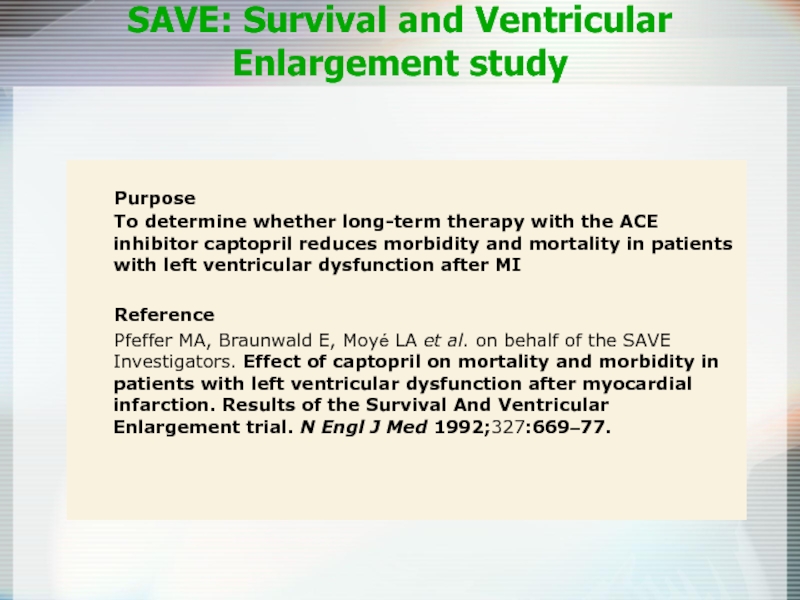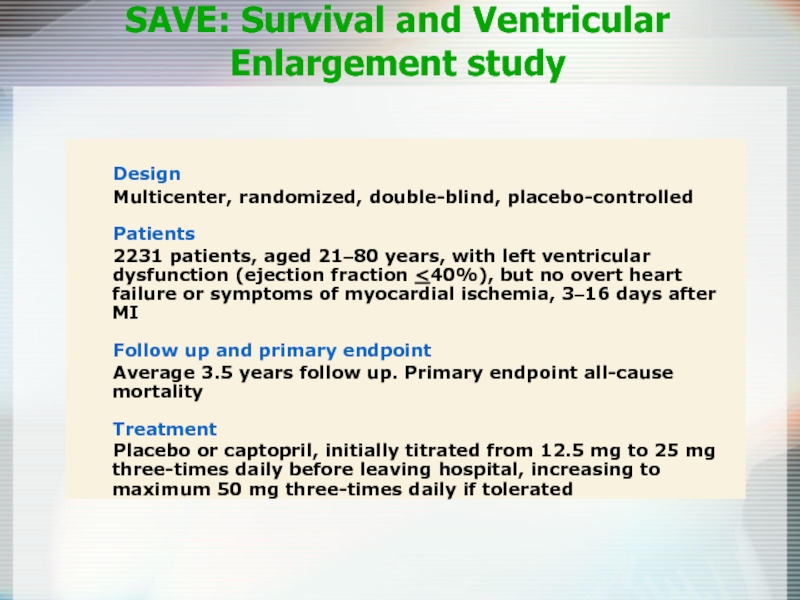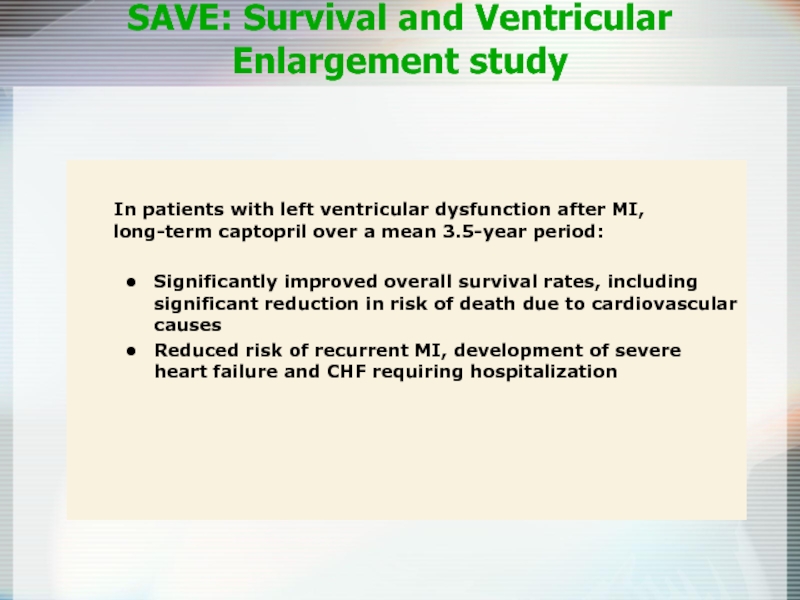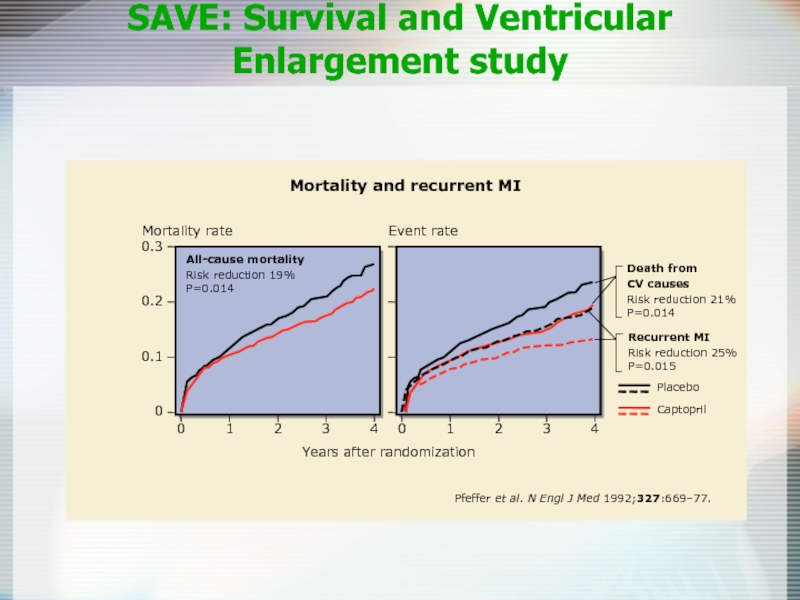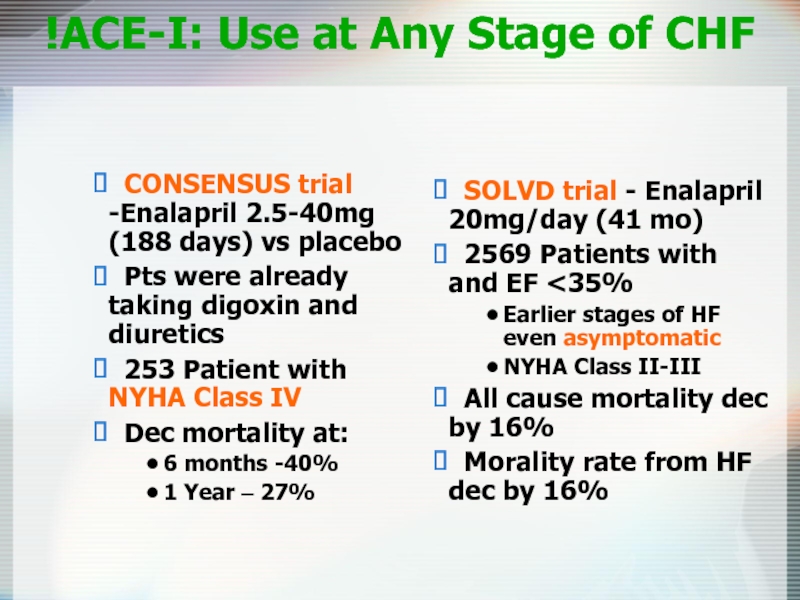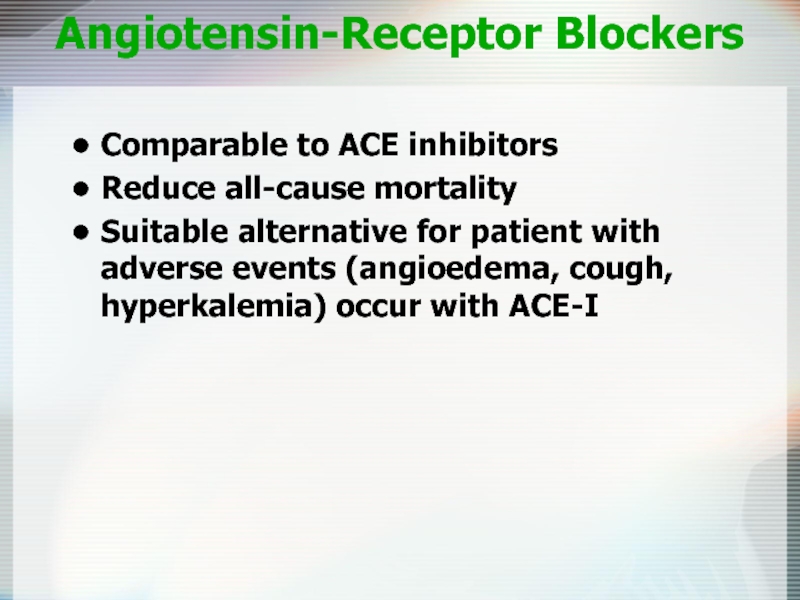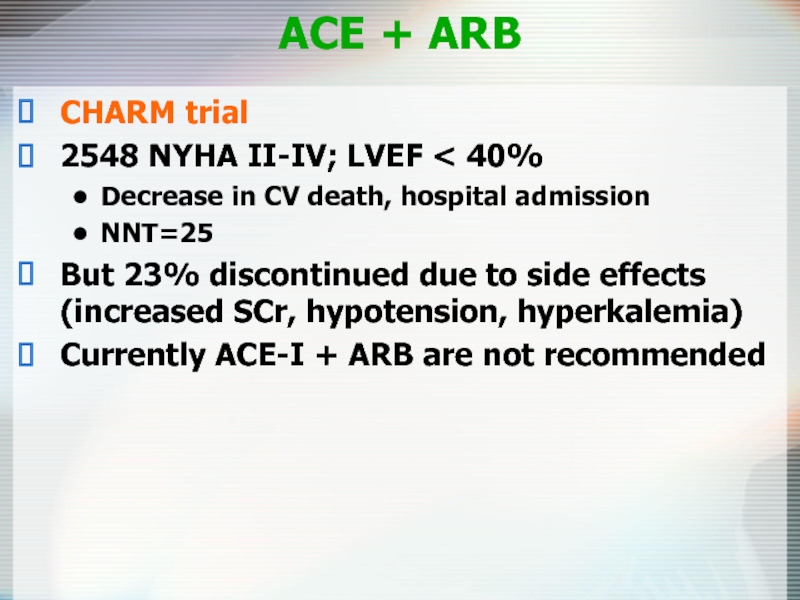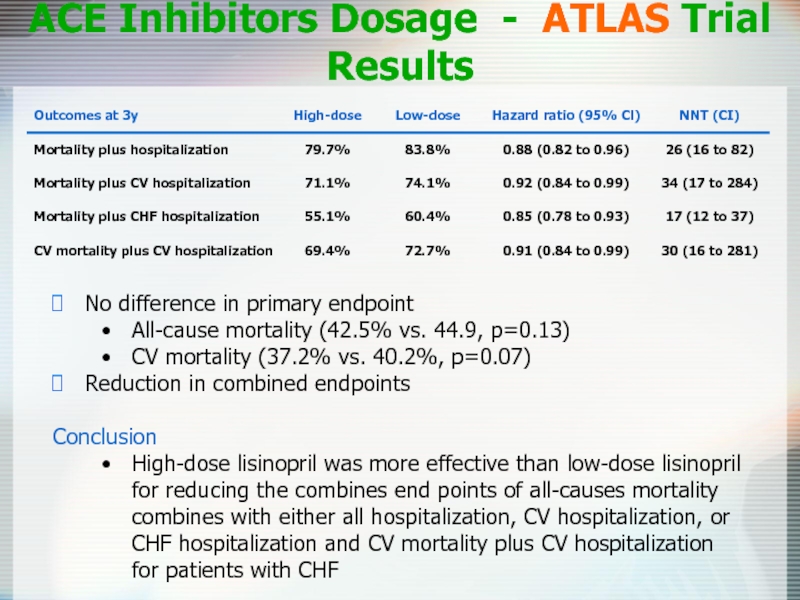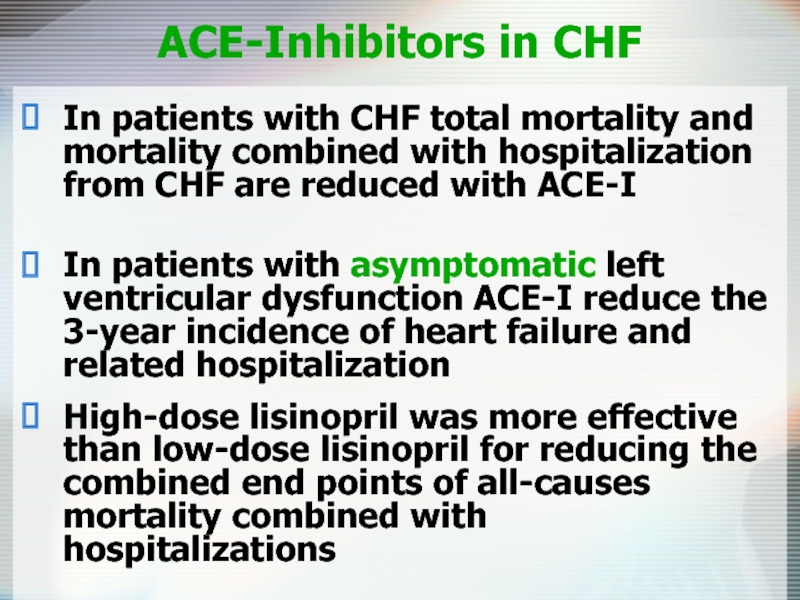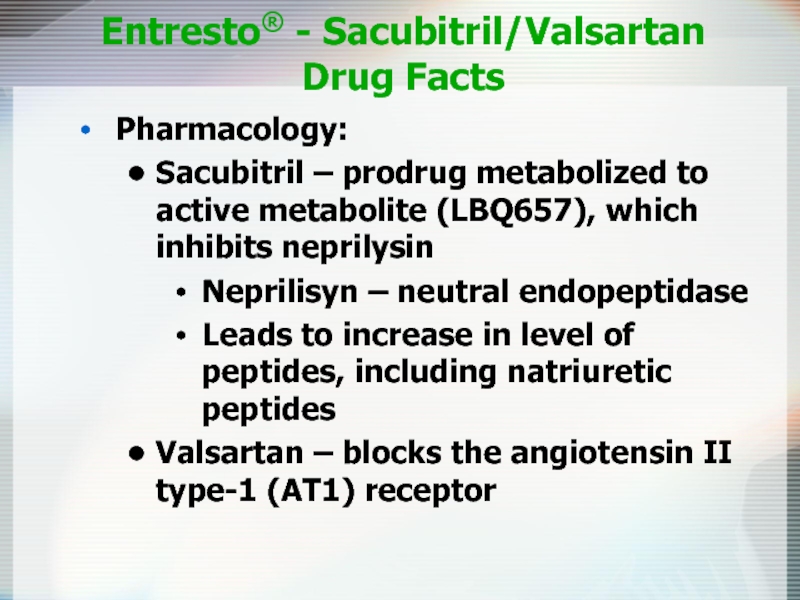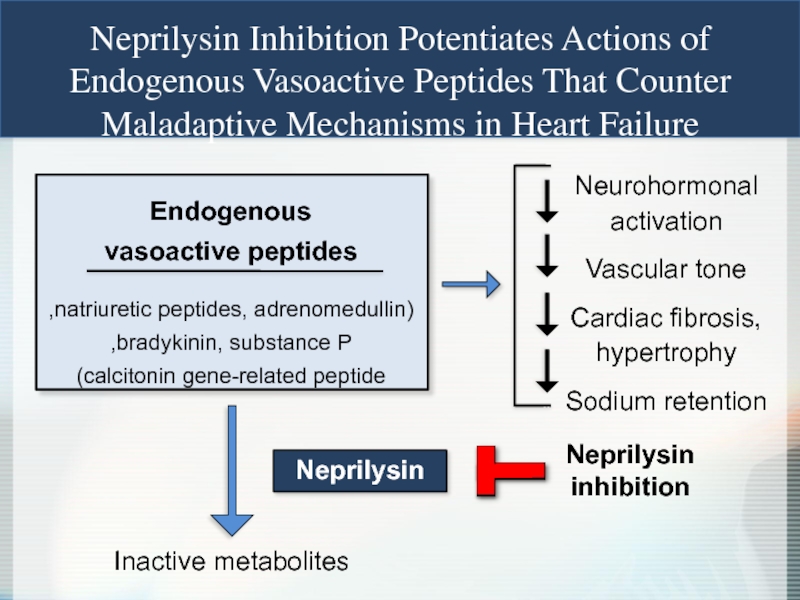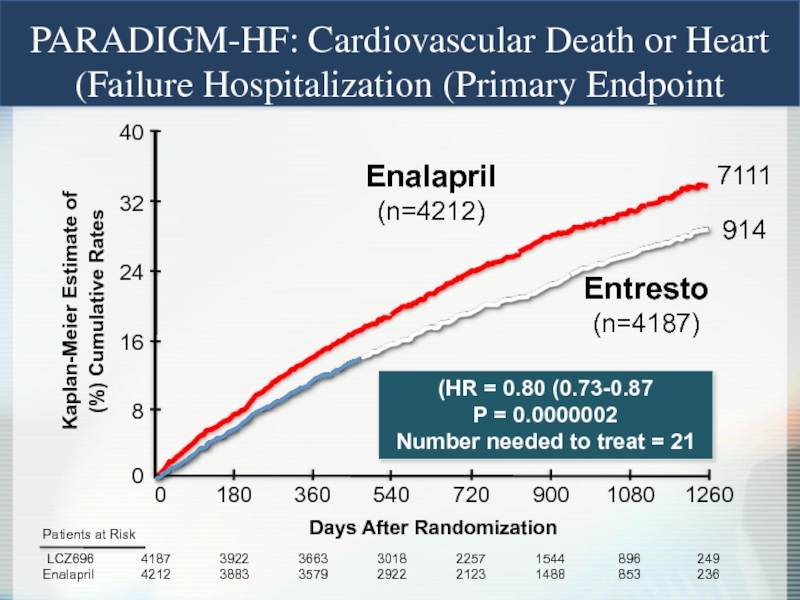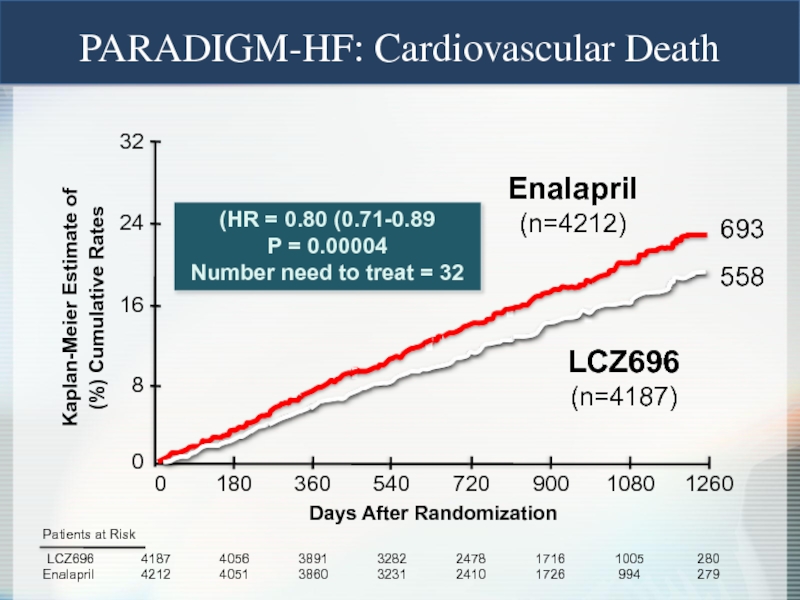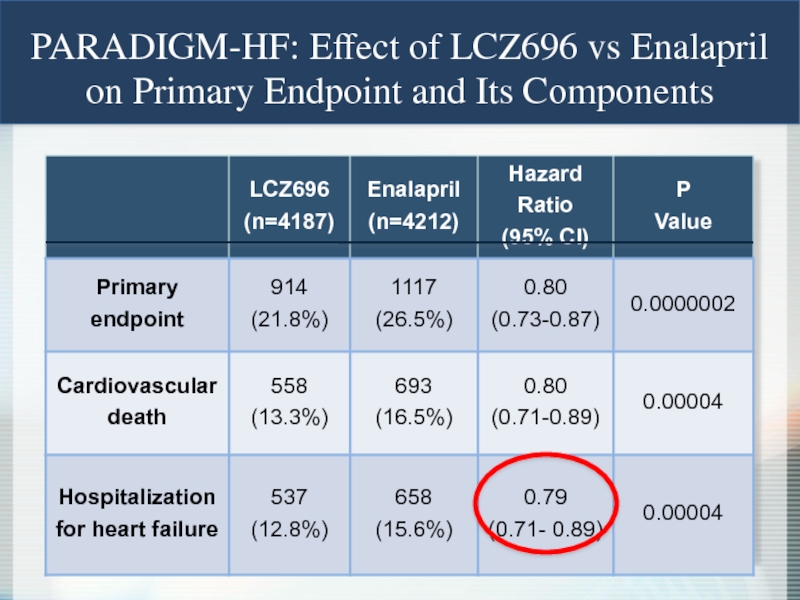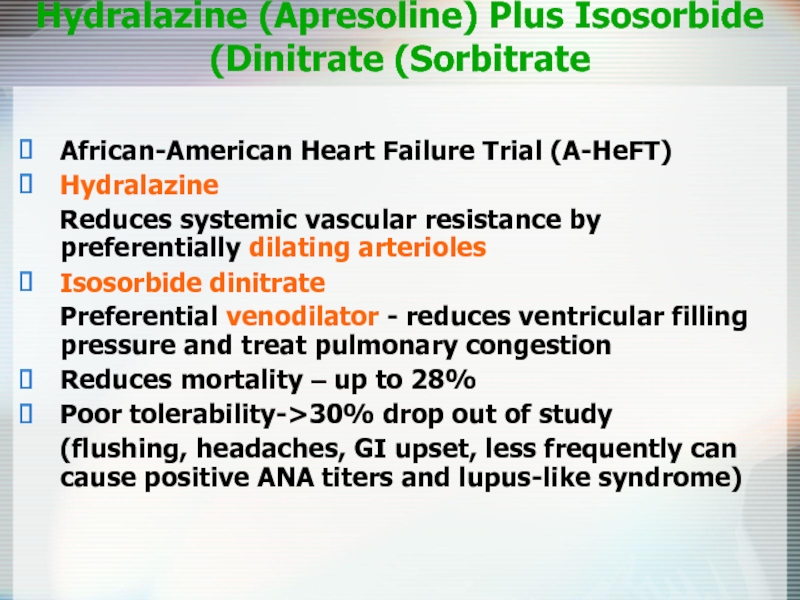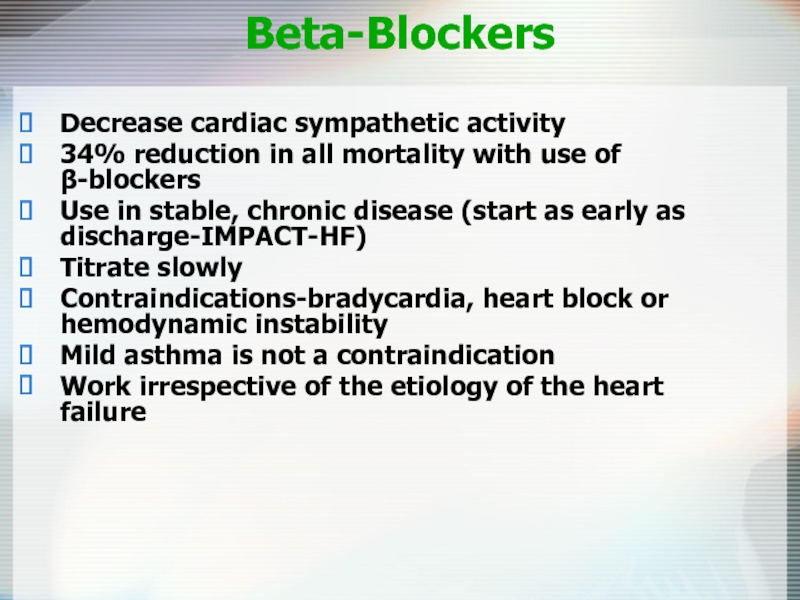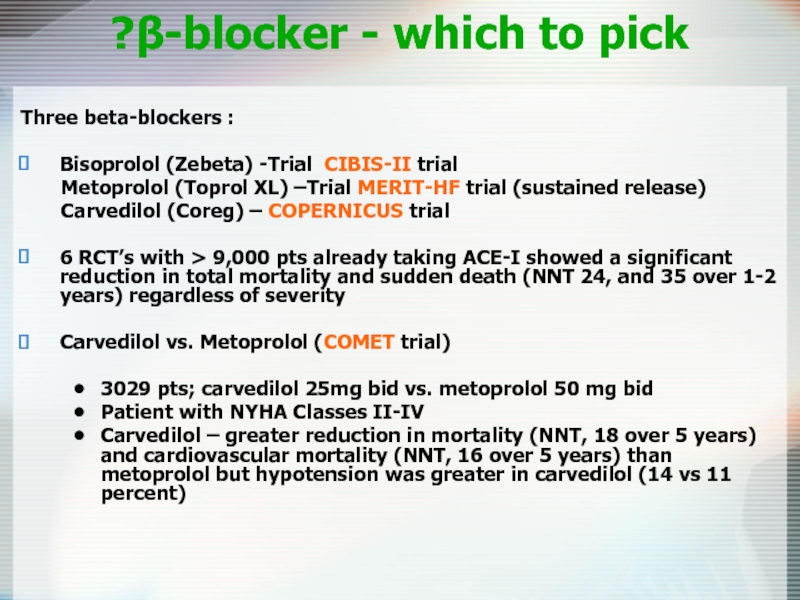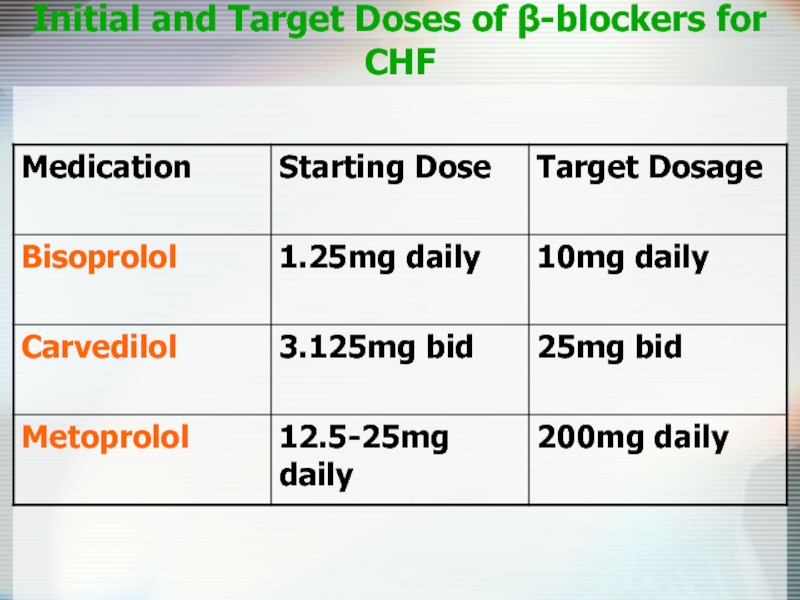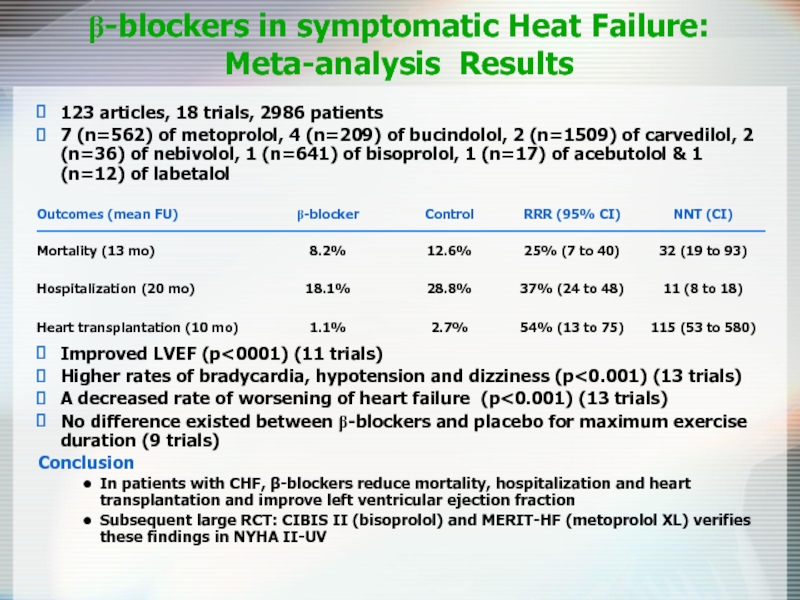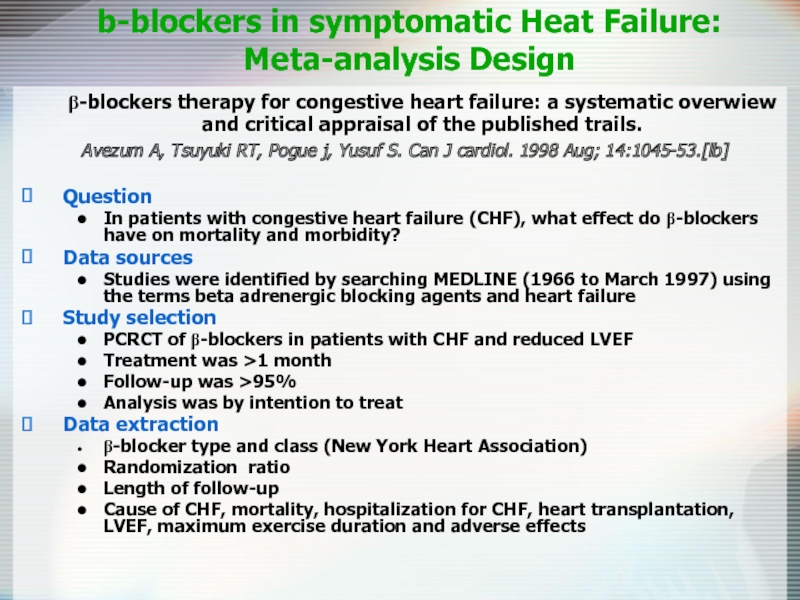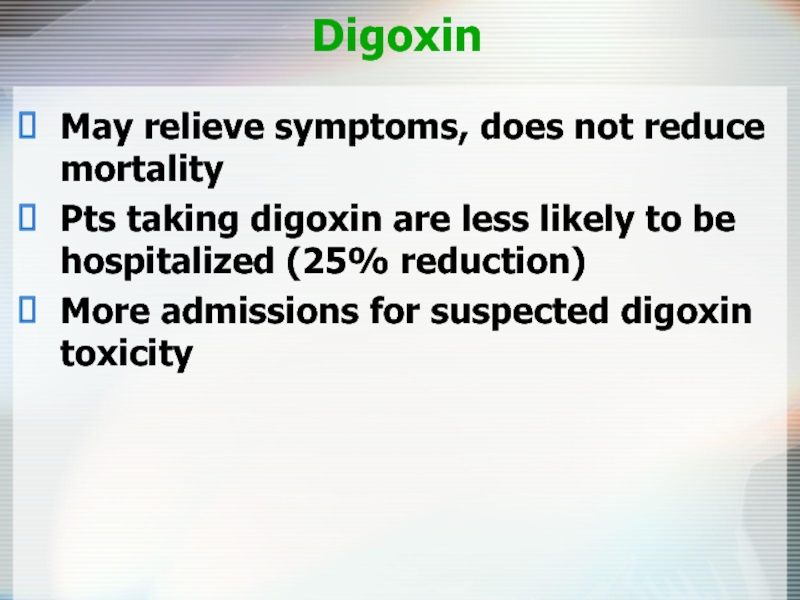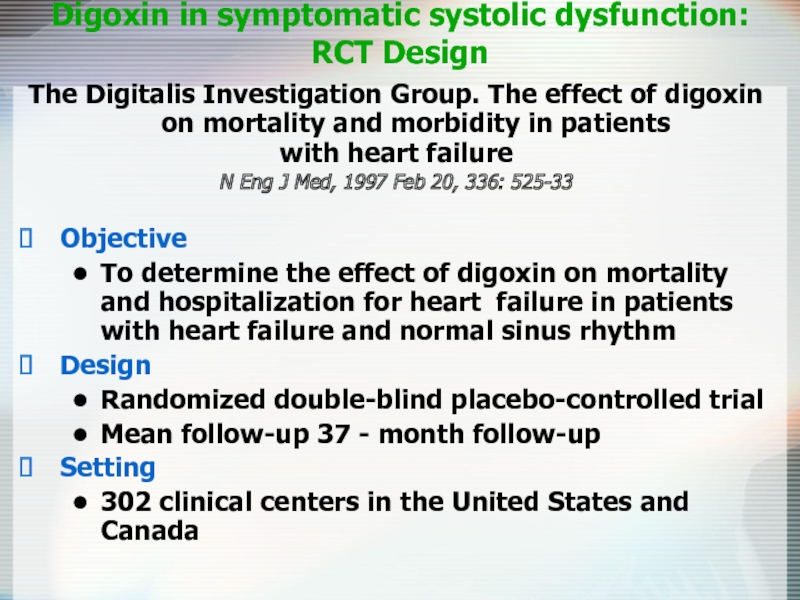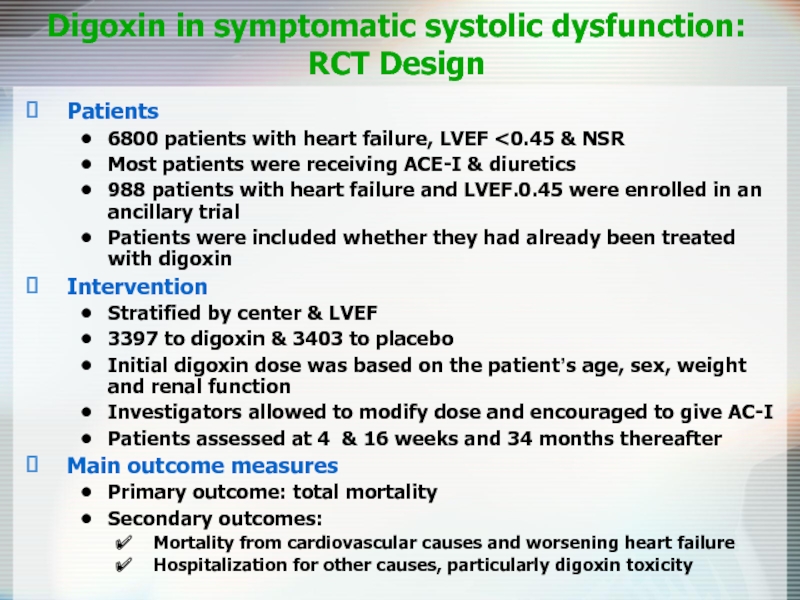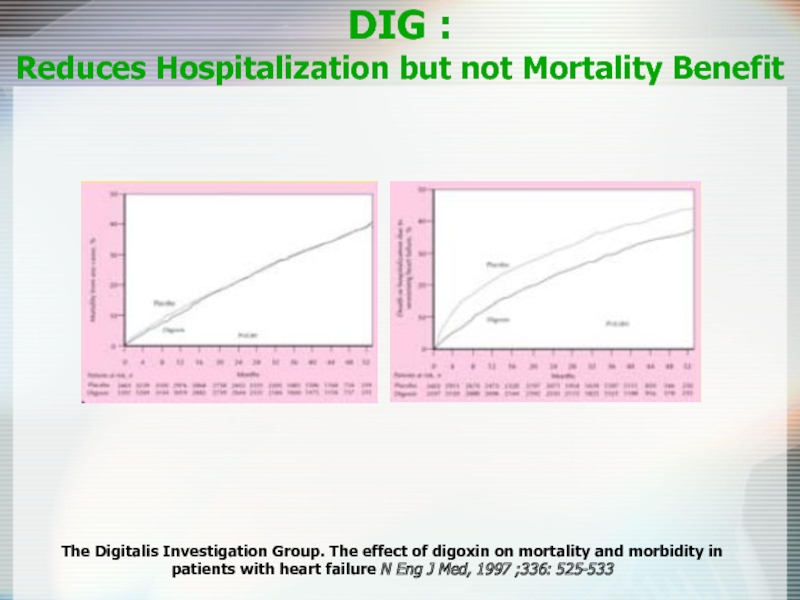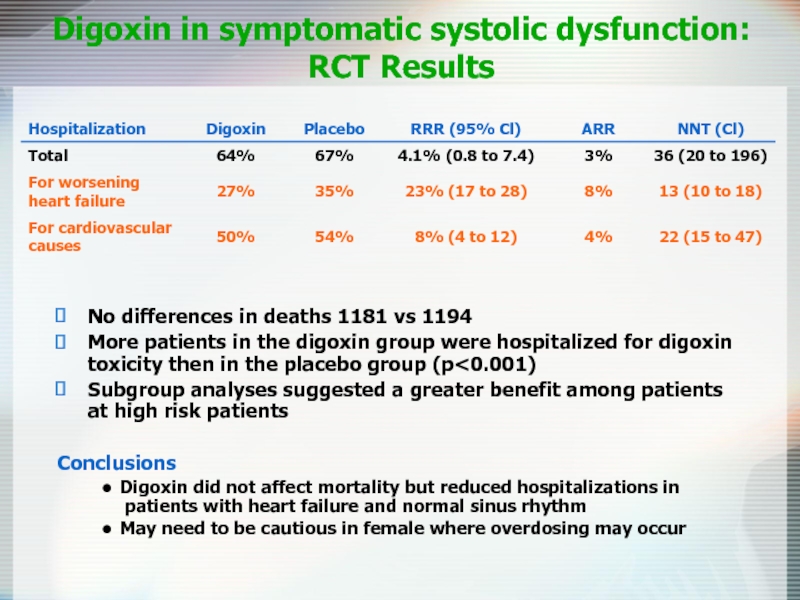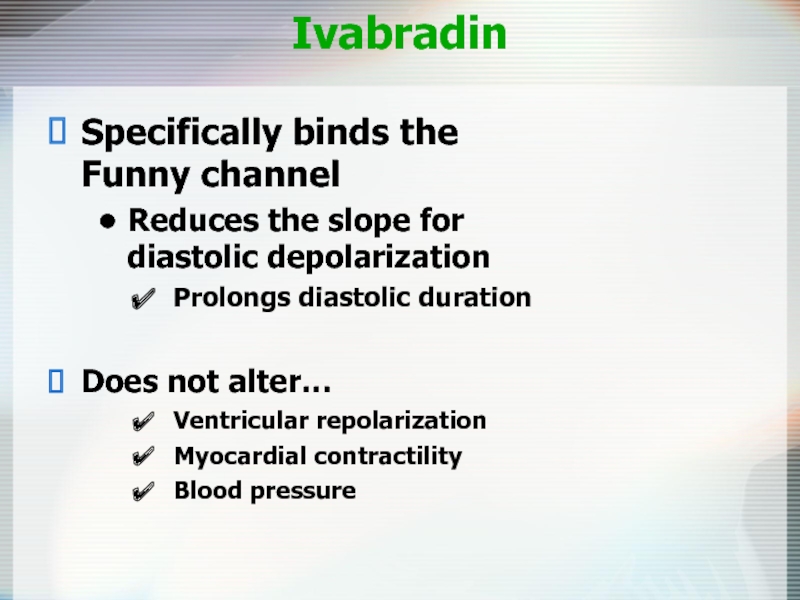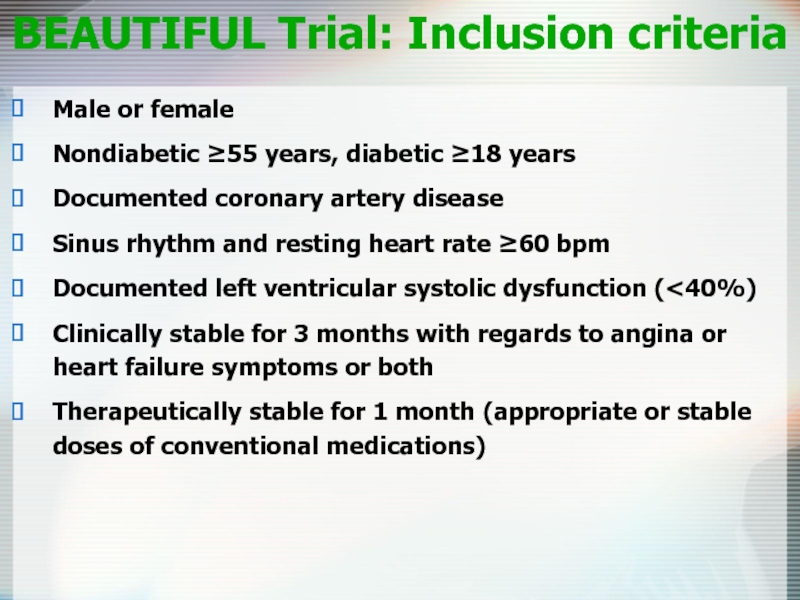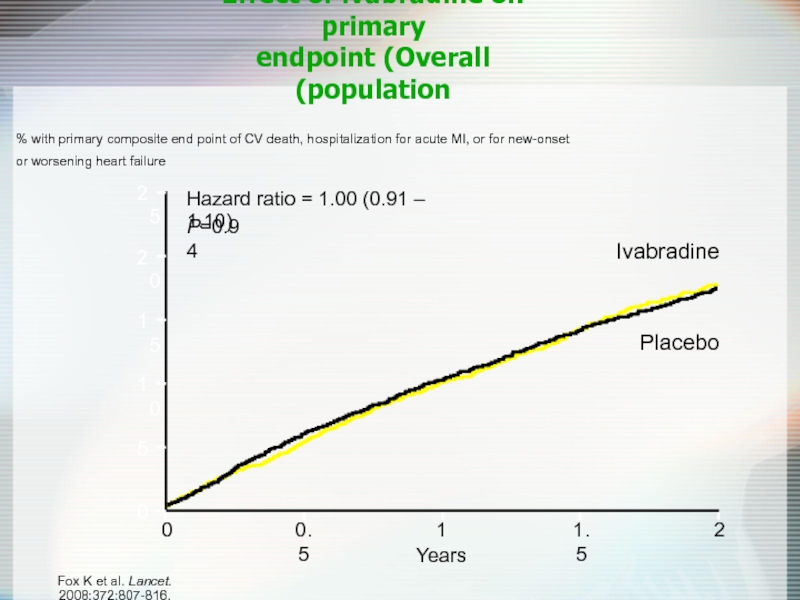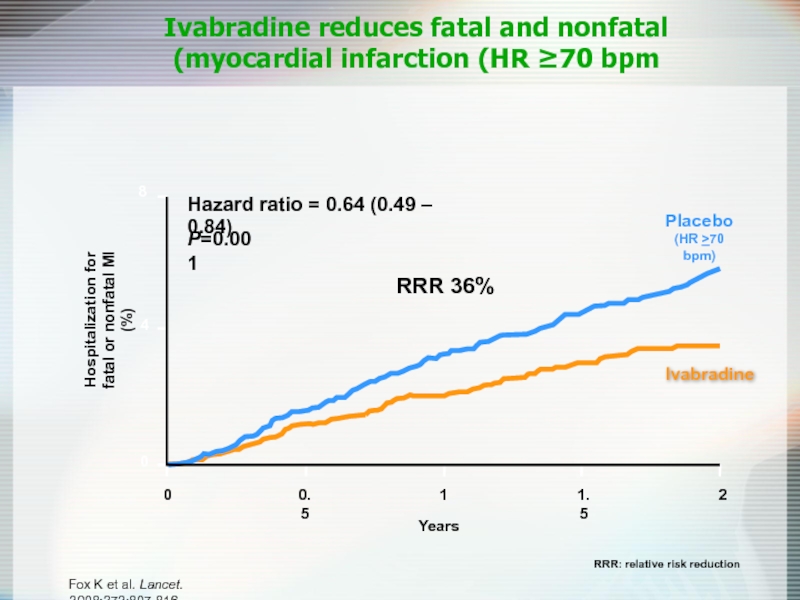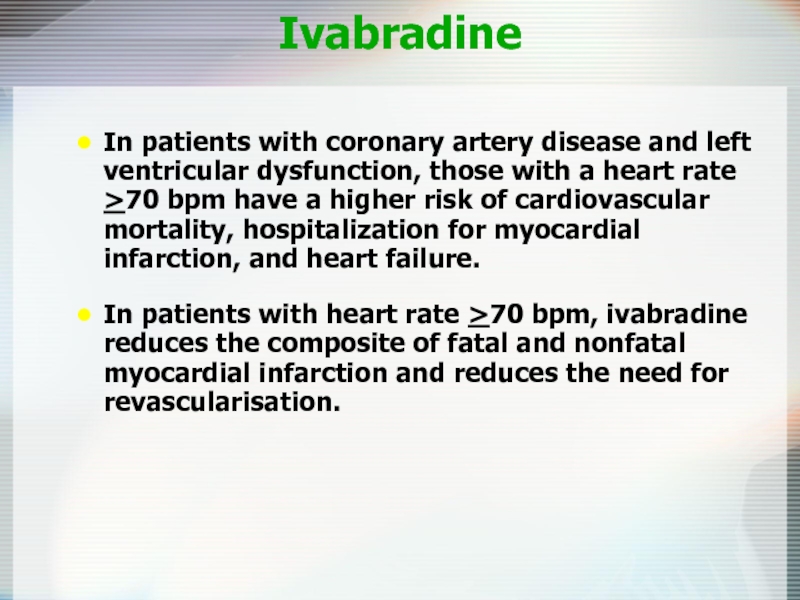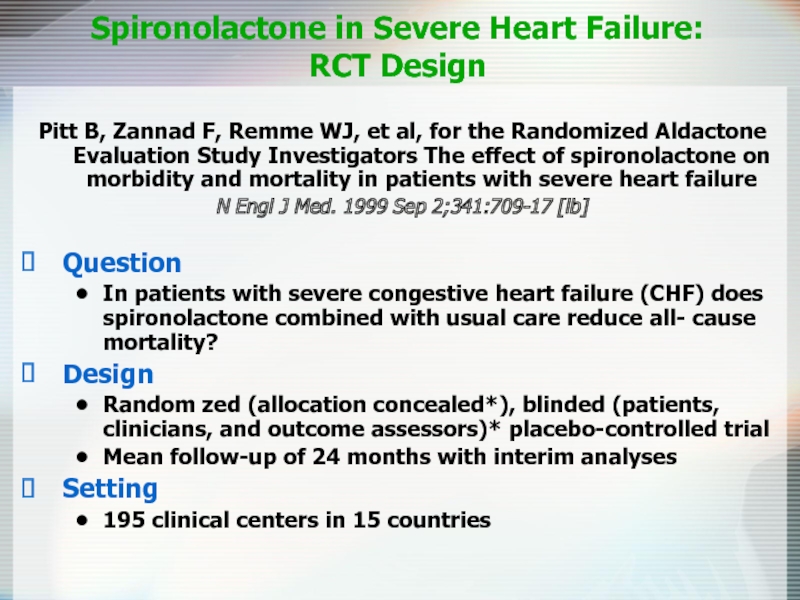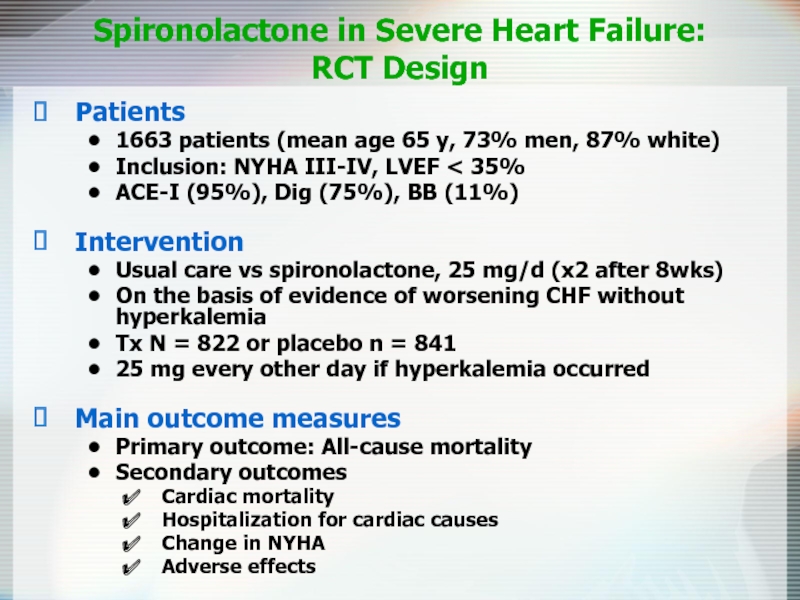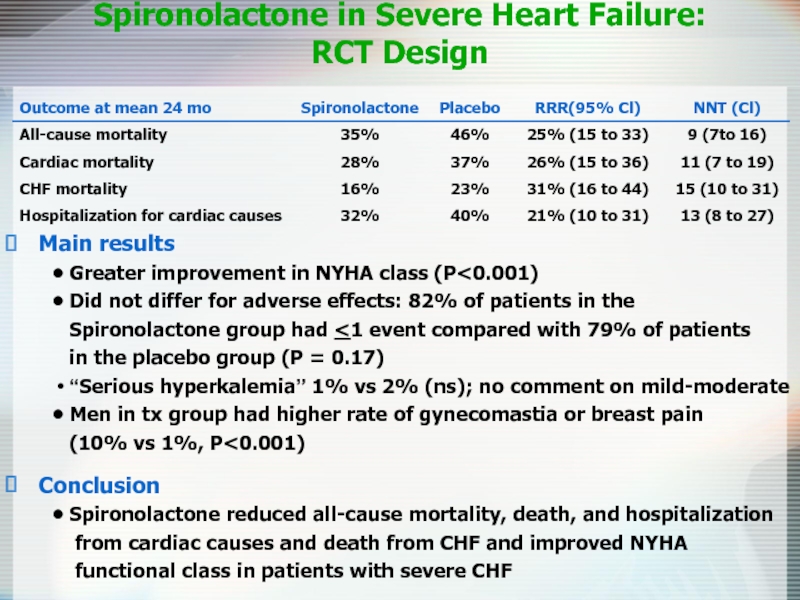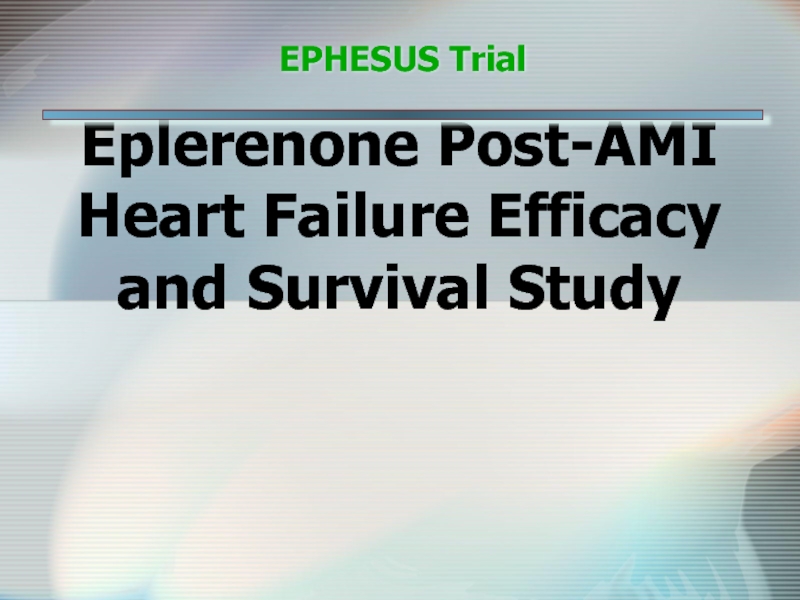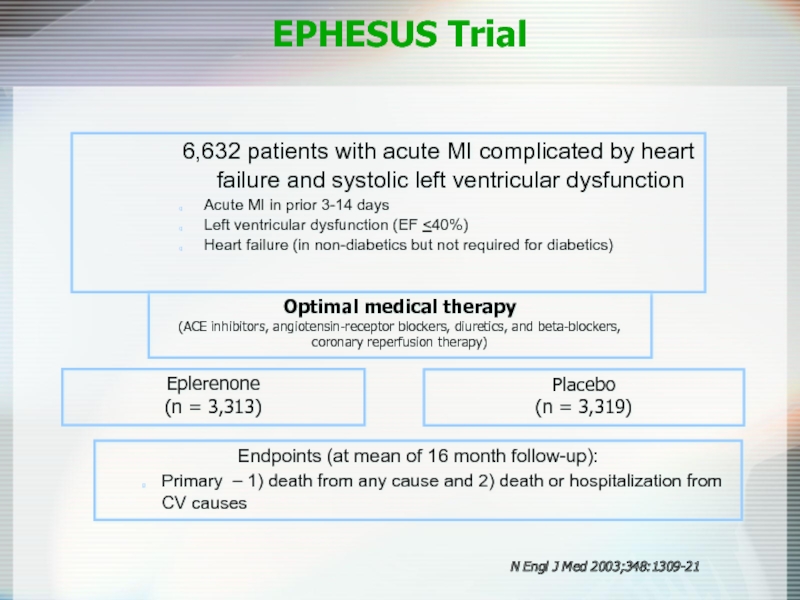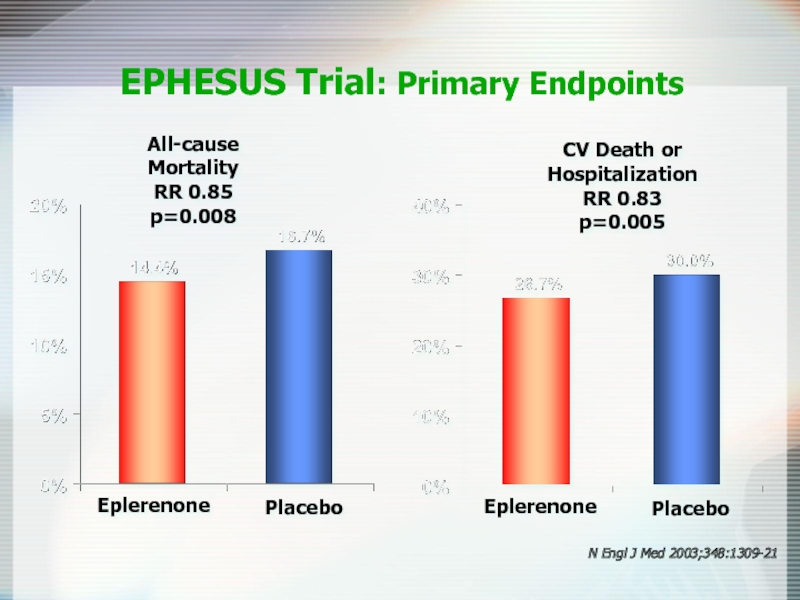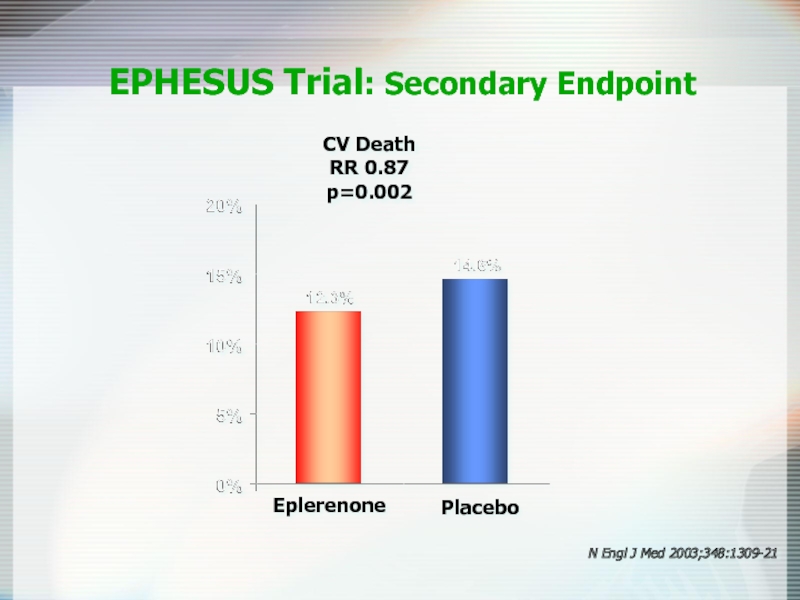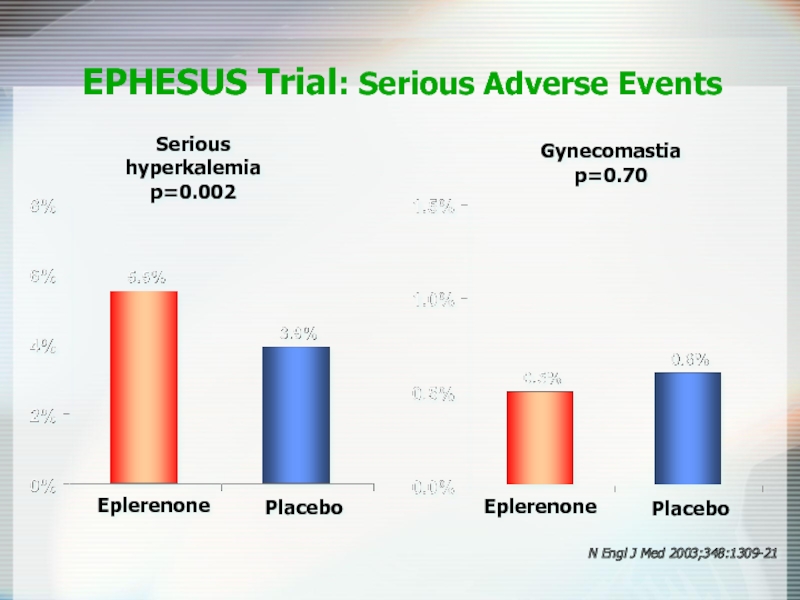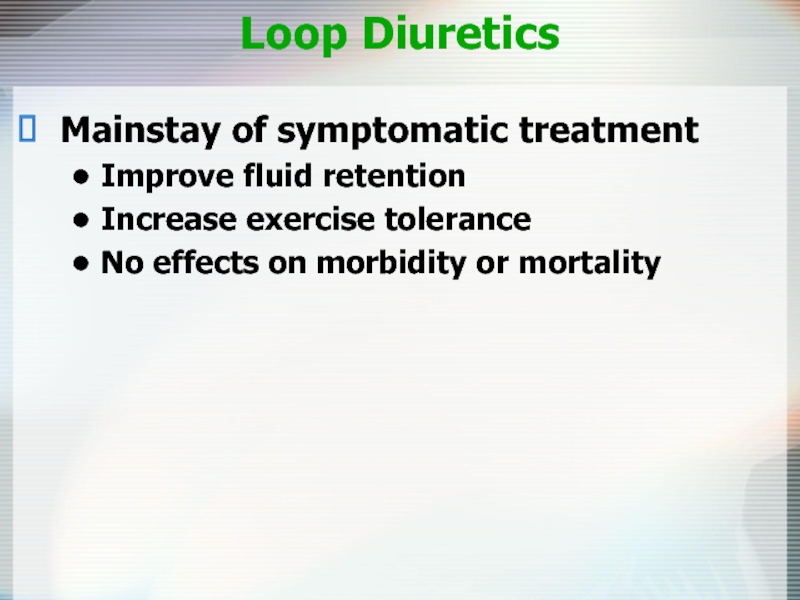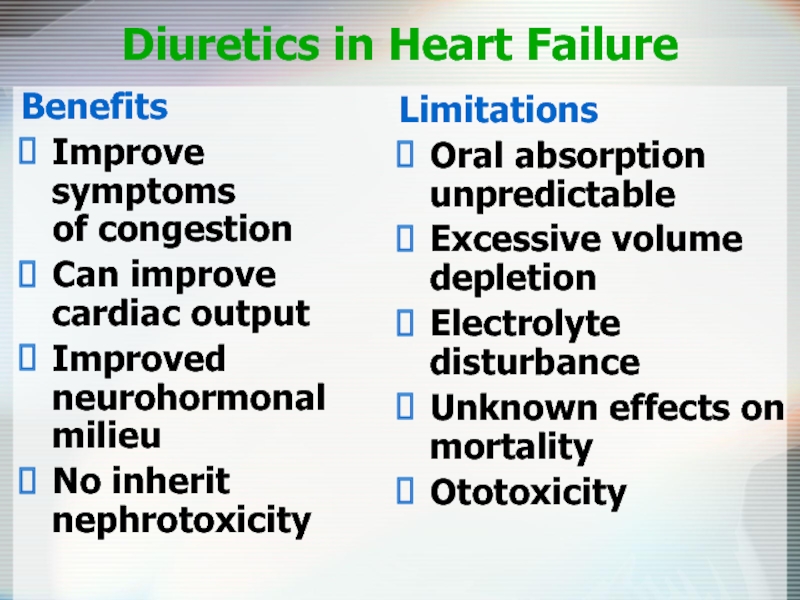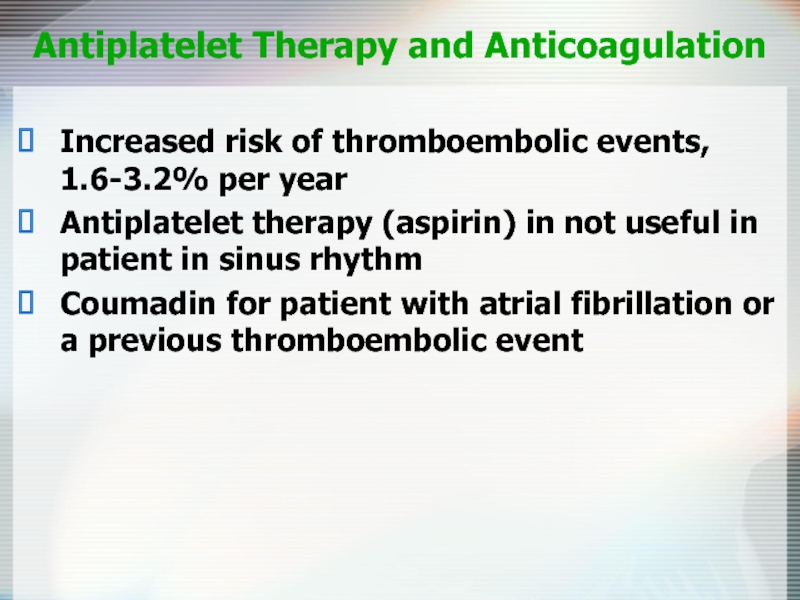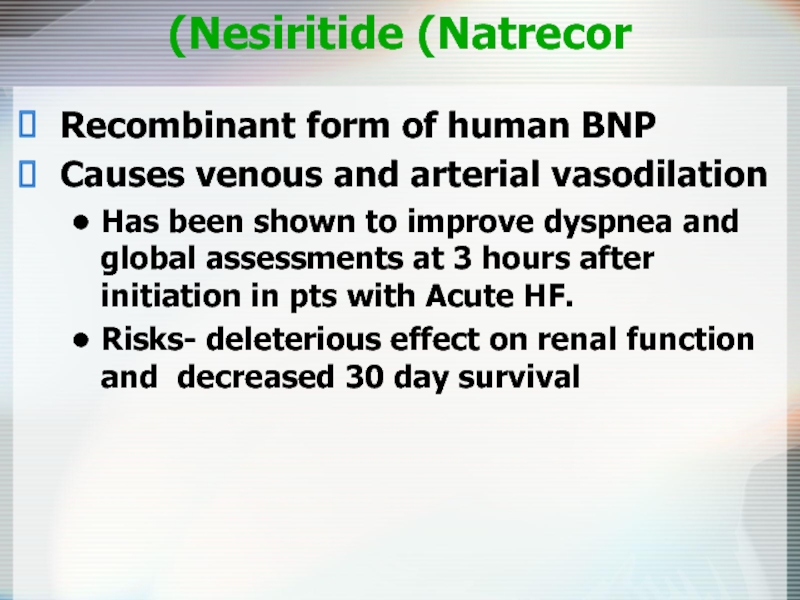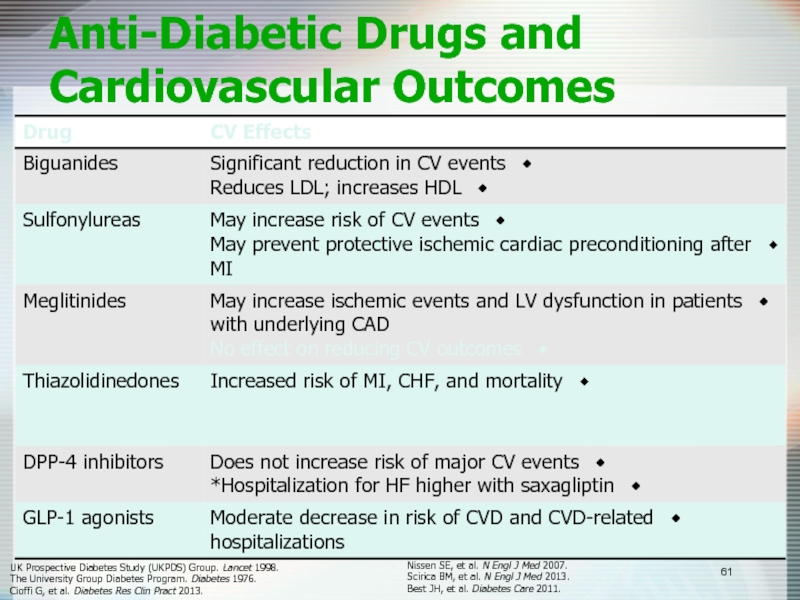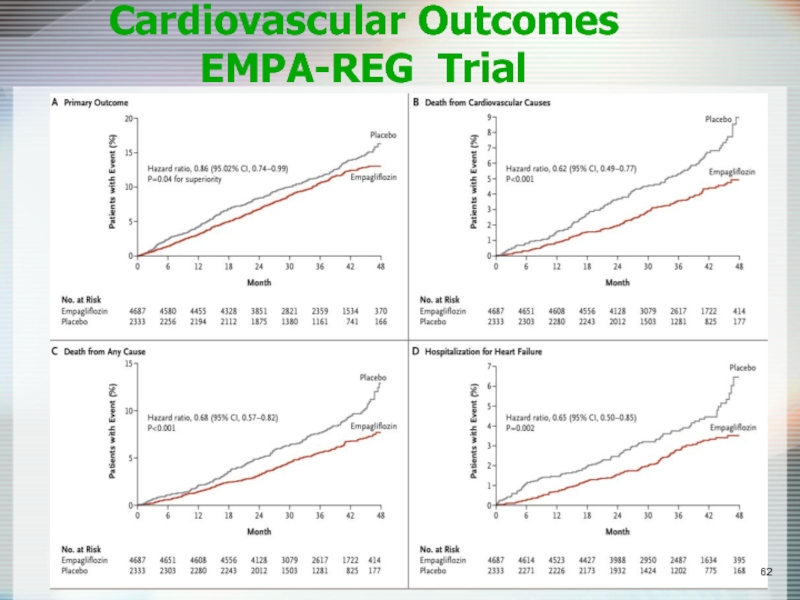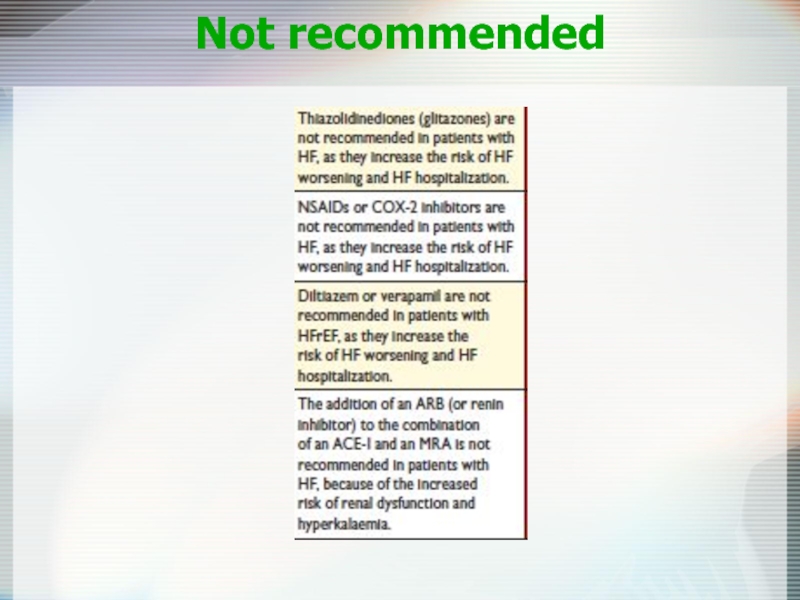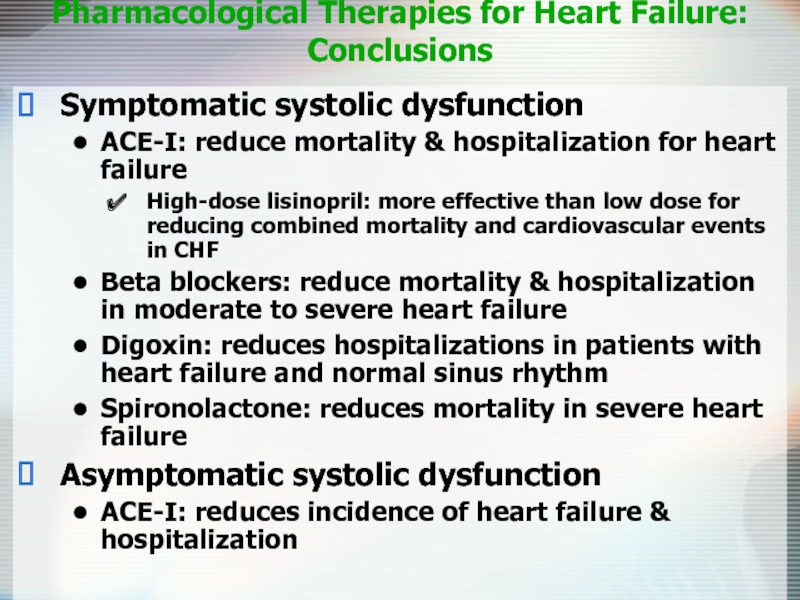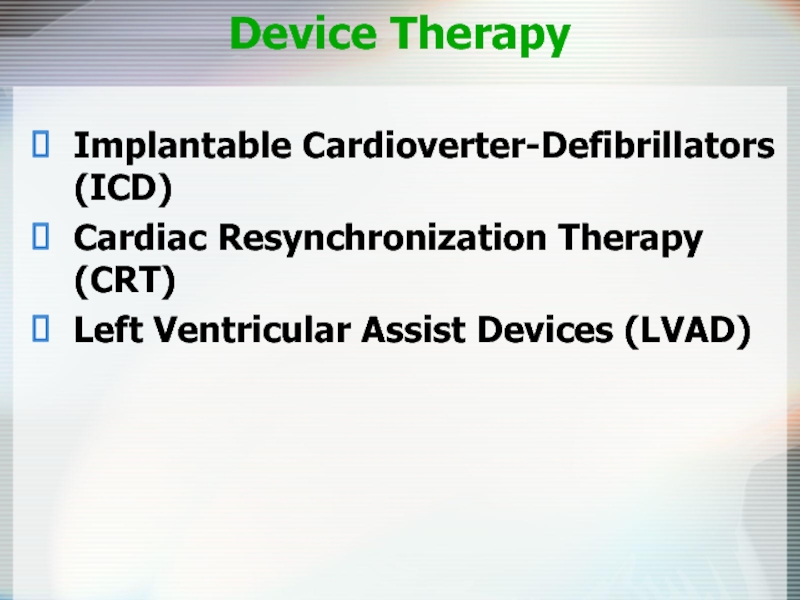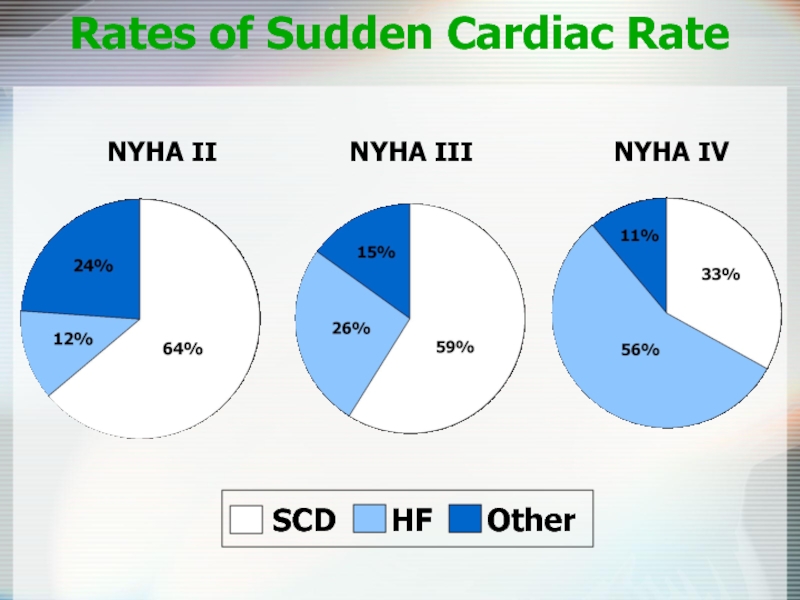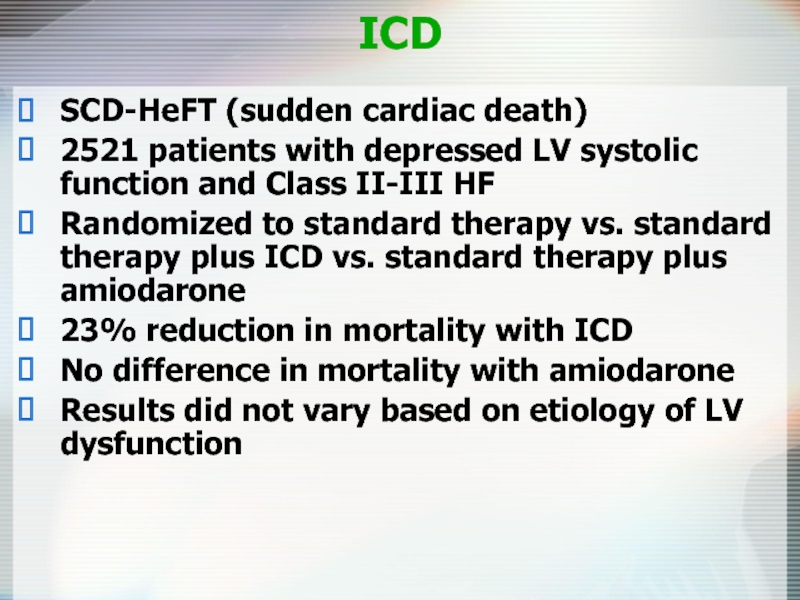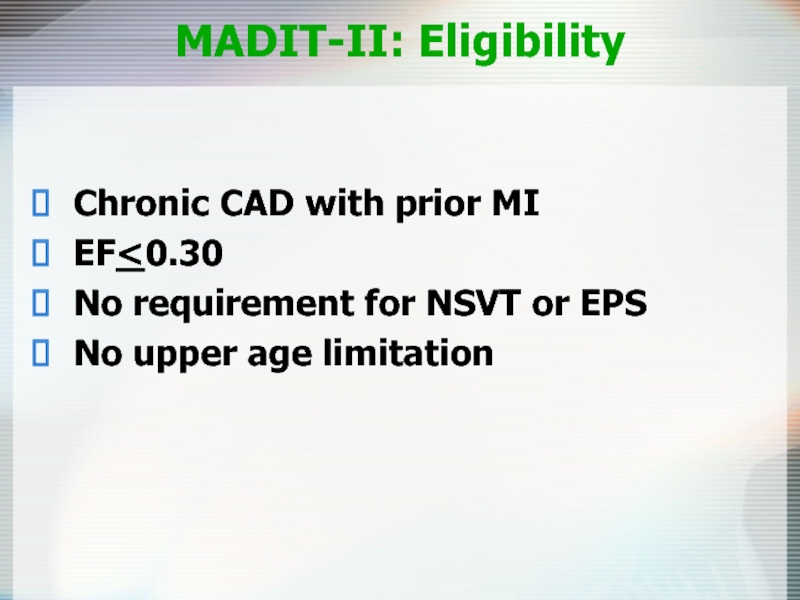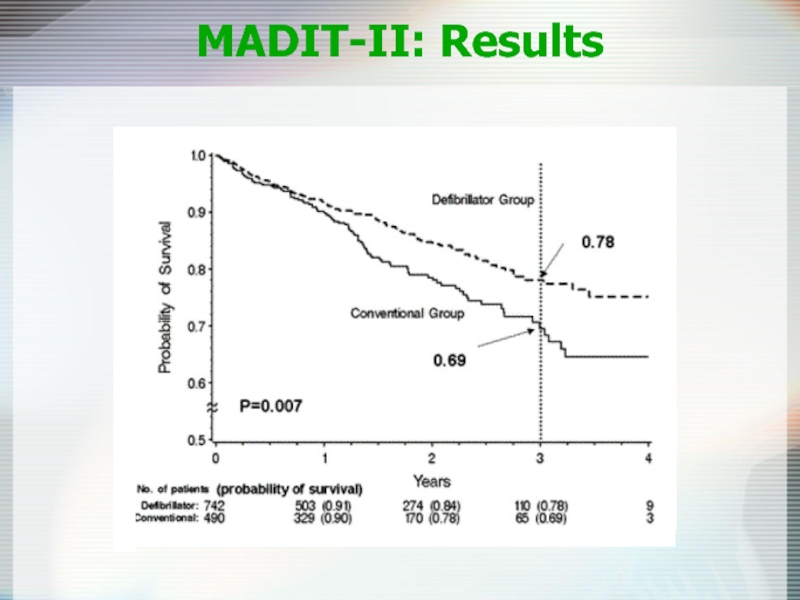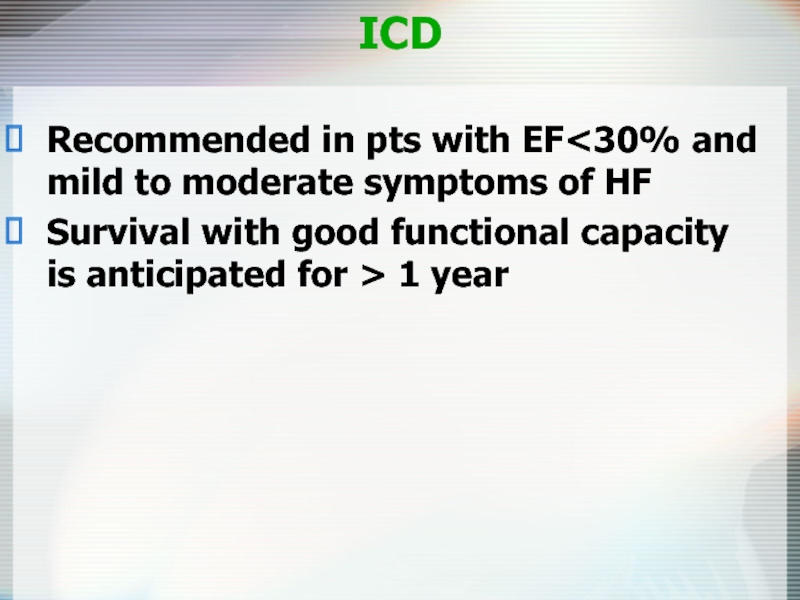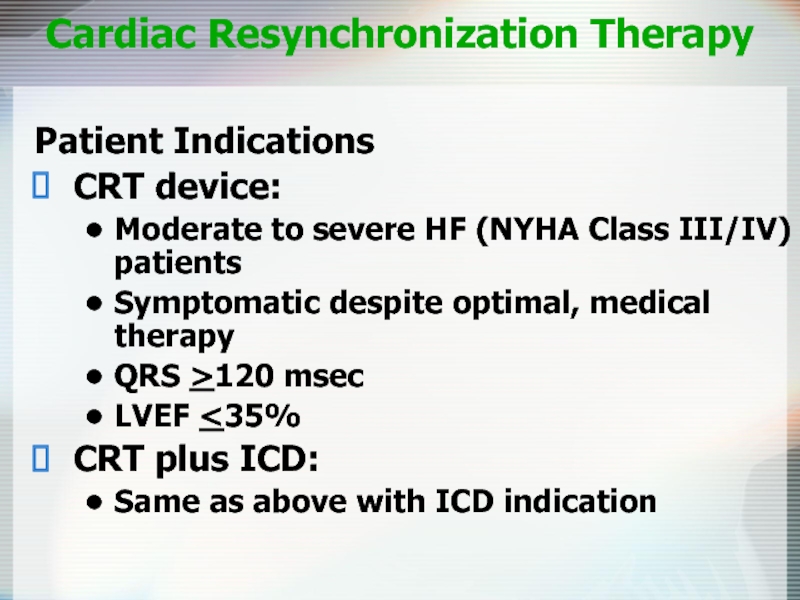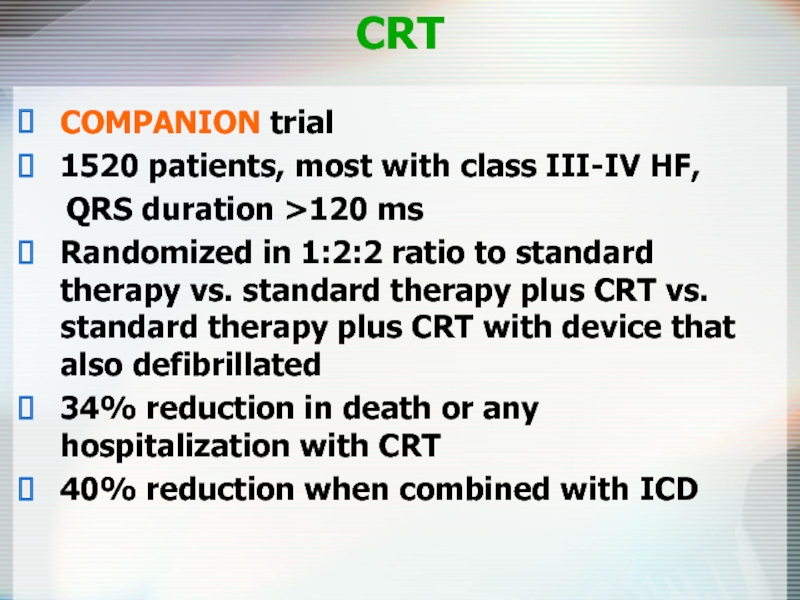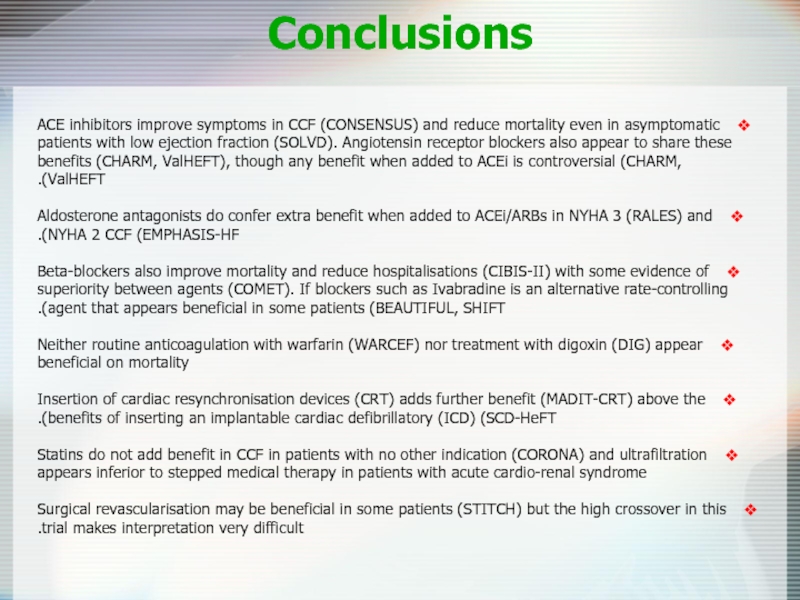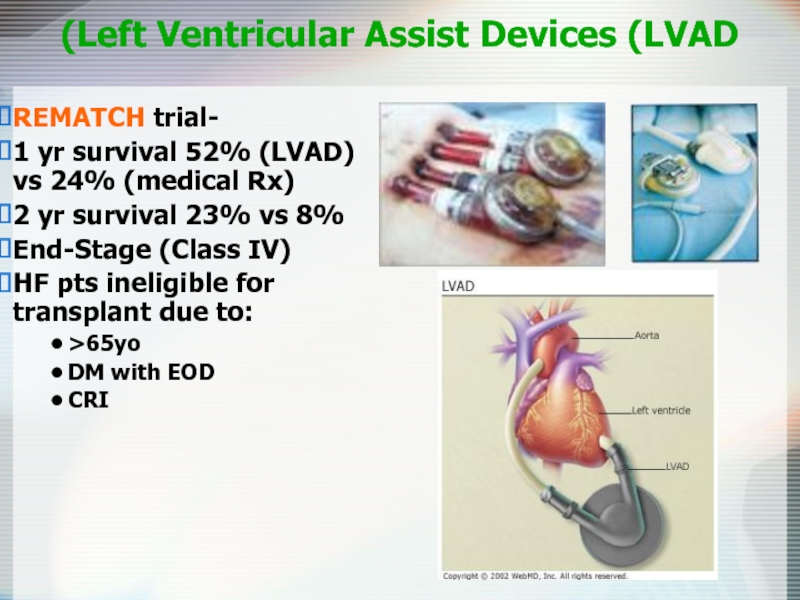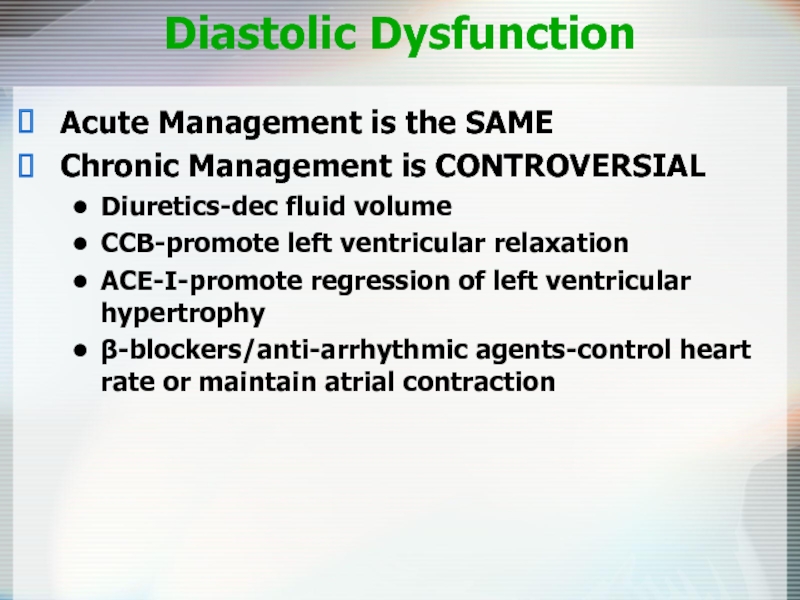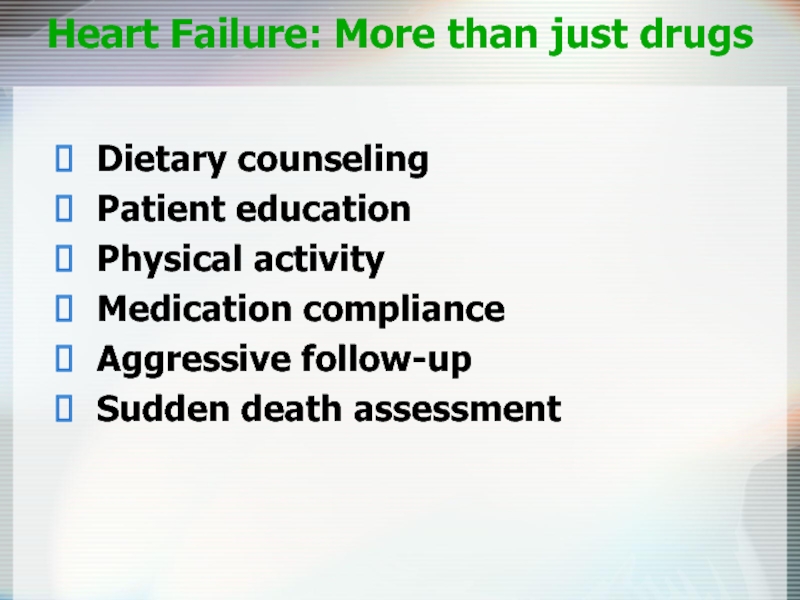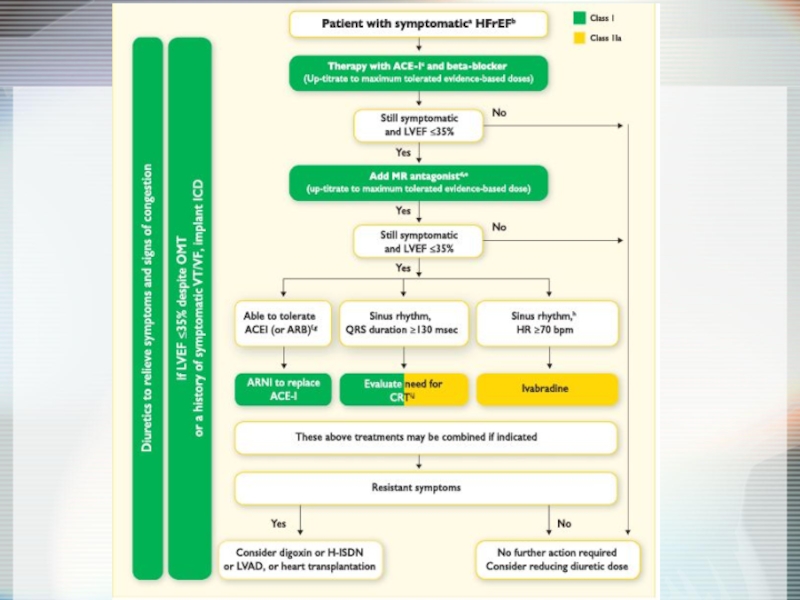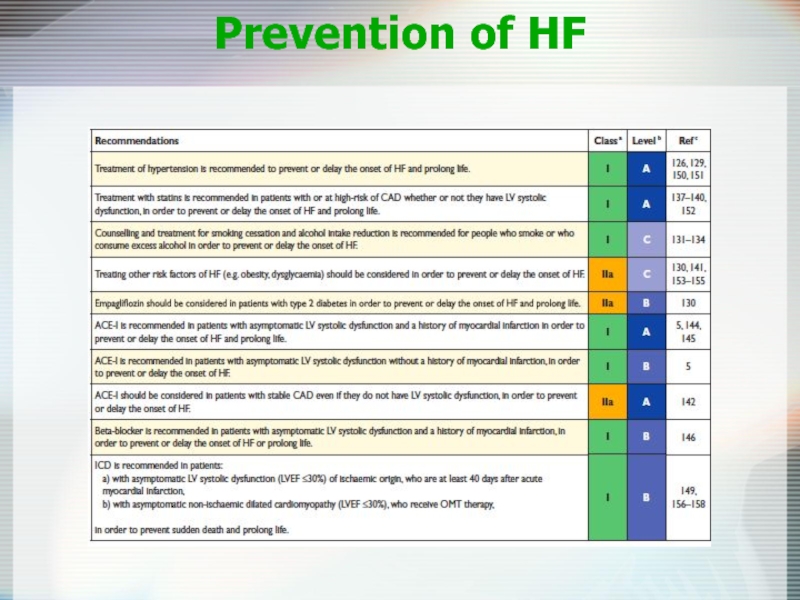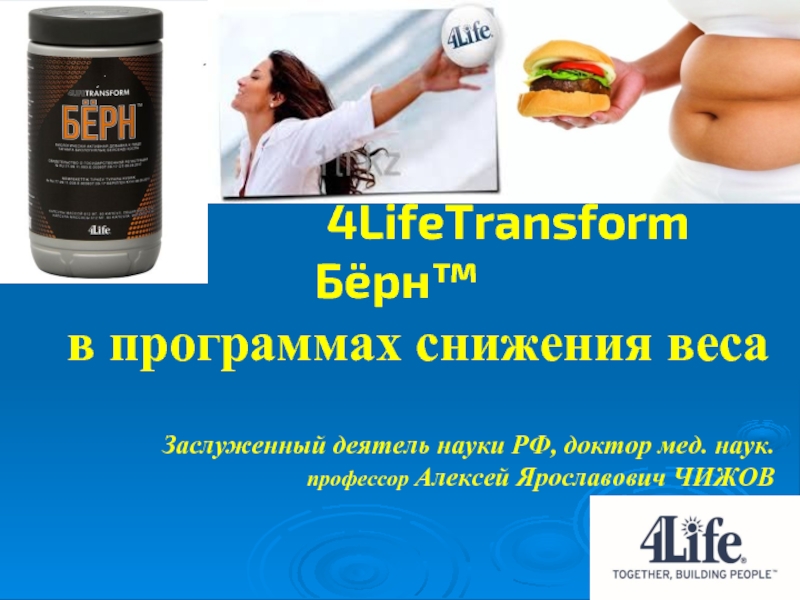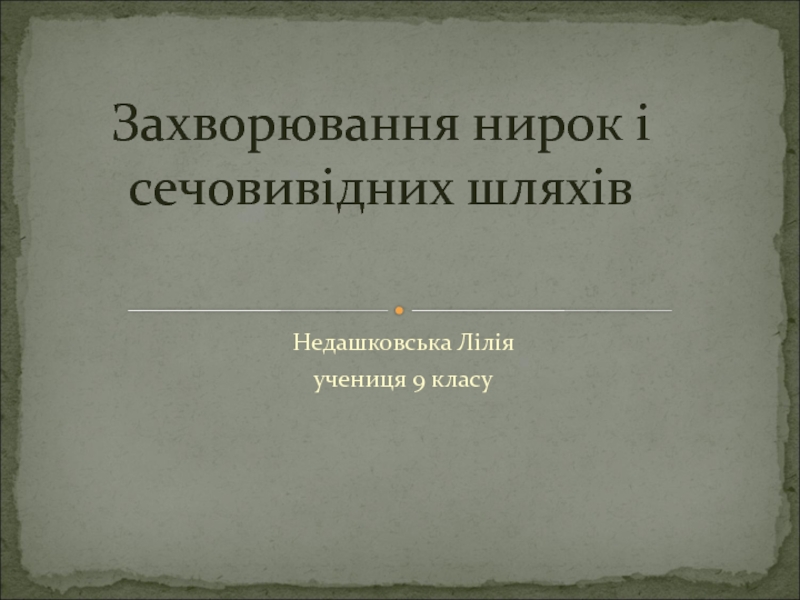- Главная
- Разное
- Дизайн
- Бизнес и предпринимательство
- Аналитика
- Образование
- Развлечения
- Красота и здоровье
- Финансы
- Государство
- Путешествия
- Спорт
- Недвижимость
- Армия
- Графика
- Культурология
- Еда и кулинария
- Лингвистика
- Английский язык
- Астрономия
- Алгебра
- Биология
- География
- Детские презентации
- Информатика
- История
- Литература
- Маркетинг
- Математика
- Медицина
- Менеджмент
- Музыка
- МХК
- Немецкий язык
- ОБЖ
- Обществознание
- Окружающий мир
- Педагогика
- Русский язык
- Технология
- Физика
- Философия
- Химия
- Шаблоны, картинки для презентаций
- Экология
- Экономика
- Юриспруденция
Congestive Heart Failure презентация
Содержание
- 1. Congestive Heart Failure
- 2. Heart Failure: Epidemiology Burden of CHF is
- 3. Definition HF is a clinical syndrome characterized
- 5. Etiologies of Chronic Heart Failure Men
- 6. Stages of Heart Failure NYHA Class Class
- 7. Types of HF
- 8. Systolic vs. Diastolic HF (HFrEF vs. HFpEF)
- 9. Subtypes of Systolic Heart Failure Low cardiac
- 10. Principles of Treatment Systolic HF ↓ Preload
- 11. Management of Heart Failure Therapies ACE-Inhibitors Beta
- 12. Diagnosis of HF Anamnesis Chest X-Ray ECG
- 14. Aims of therapy Reduce symptoms & improve
- 15. Targets for treatment: Neurohormonal responses to impaired cardiac performance
- 16. Renin-Angiotensin Cascade & β-blockers
- 17. Purpose To determine whether
- 18. Design Multicenter, randomized, double-blind,
- 19. In patients with left
- 20. 0 0 1
- 21. ACE-I: Use at Any Stage of CHF!
- 22. Mortality as a Function of Tx
- 23. Angiotensin-Receptor Blockers Comparable to ACE inhibitors
- 24. ACE + ARB CHARM trial 2548
- 25. ACE Inhibitors Dosage - ATLAS Trial Results
- 26. ACE-Inhibitors in CHF In patients with CHF
- 27. Entresto® - Sacubitril/Valsartan Drug Facts Pharmacology:
- 28. Neprilysin Inhibition Potentiates Actions
- 29. Prospective comparison of ARNI with
- 30. 0 16 32 40 24 8 Enalapril
- 31. Enalapril (n=4212) LCZ696 (n=4187) HR = 0.80
- 32. PARADIGM-HF: Effect of LCZ696 vs Enalapril on Primary Endpoint and Its Components
- 33. Hydralazine (Apresoline) Plus Isosorbide Dinitrate (Sorbitrate) African-American
- 34. Beta-Blockers Decrease cardiac sympathetic activity 34%
- 35. β-blocker - which to pick? Three beta-blockers
- 36. Initial and Target Doses of β-blockers for CHF
- 37. β-blockers in symptomatic Heat Failure: Meta-analysis
- 38. β-blockers therapy for congestive heart failure: a
- 39. Digoxin May relieve symptoms, does not reduce
- 40. The Digitalis Investigation Group. The effect of
- 41. Digoxin in symptomatic systolic dysfunction: RCT Design Patients 6800 patients with heart failure, LVEF
- 42. DIG : Reduces Hospitalization but not
- 43. Digoxin in symptomatic systolic dysfunction: RCT Results
- 44. Ivabradin Specifically binds the Funny channel Reduces
- 45. BEAUTIFUL Trial: Inclusion criteria Male or female
- 46. Effect of ivabradine on primary endpoint (Overall
- 47. Ivabradine reduces fatal and nonfatal myocardial
- 48. Ivabradine In patients with coronary artery disease
- 49. Spironolactone in Severe Heart Failure: RCT Design
- 50. Spironolactone in Severe Heart Failure: RCT
- 51. Spironolactone in Severe Heart Failure: RCT
- 52. Eplerenone Post-AMI Heart Failure Efficacy and Survival Study EPHESUS Trial
- 53. Eplerenone (n = 3,313) Placebo (n
- 54. All-cause Mortality RR 0.85 p=0.008 EPHESUS
- 55. CV Death RR 0.87 p=0.002 EPHESUS Trial:
- 56. Serious hyperkalemia p=0.002 EPHESUS Trial: Serious Adverse
- 57. Loop Diuretics Mainstay of symptomatic treatment Improve
- 58. Diuretics in Heart Failure Benefits Improve symptoms
- 59. Antiplatelet Therapy and Anticoagulation Increased risk of
- 60. Nesiritide (Natrecor) Recombinant form of human
- 61. Anti-Diabetic Drugs and Cardiovascular Outcomes UK Prospective
- 62. Cardiovascular Outcomes EMPA-REG Trial
- 63. Not recommended
- 64. Pharmacological Therapies for Heart Failure: Conclusions
- 65. Device Therapy Implantable Cardioverter-Defibrillators (ICD) Cardiac Resynchronization Therapy (CRT) Left Ventricular Assist Devices (LVAD)
- 66. Rates of Sudden Cardiac Rate NYHA II
- 67. ICD SCD-HeFT (sudden cardiac death) 2521 patients
- 68. MADIT-II: Eligibility Chronic CAD with prior MI EF
- 69. MADIT-II: Results
- 70. ICD Recommended in pts with EF 1 year
- 71. Cardiac Resynchronization Therapy Patient Indications
- 72. CRT COMPANION trial 1520 patients, most with
- 73. Conclusions ACE inhibitors improve symptoms in CCF
- 74. Left Ventricular Assist Devices (LVAD) REMATCH trial-
- 75. Diastolic Dysfunction 20-40% of presenting CHF syndrome
- 76. Diastolic Dysfunction Acute Management is the SAME
- 77. Heart Failure: More than just drugs
- 79. Prevention of HF
Слайд 2Heart Failure: Epidemiology
Burden of CHF is staggering
5 million in US (1.5%
500.000 cases annually
In the elderly
6-10% prevalence
80% hospitalized with HF
250.000 death/year attributable to CHF
$38 billion (5.4% of healthcare cost)
Слайд 3Definition
HF is a clinical syndrome characterized by typical symptoms (e.g. breathlessness,
crackles and peripheral edema) caused by a structural and/or functional cardiac abnormality, resulting in a reduced cardiac output and/or elevated intracardiac pressures at rest or during stress.
Слайд 6Stages of Heart Failure
NYHA Class
Class I : Symptoms with more
Class II: Symptoms with ordinary activity
Class III: Symptoms with minimal activity
Class IV: Symptoms at rest
Слайд 8Systolic vs. Diastolic HF
(HFrEF vs. HFpEF)
Diastolic dysfunction
EF normal or increased
Hypertension
Due to
Systolic dysfunction
EF < 40%
Usually from coronary disease
Due to ischemia-induced decrease in contractility
A combination of both
Слайд 9Subtypes of Systolic Heart Failure
Low cardiac output
High output
Severe anemia
AV malformations
Hyperthyroidism
Left
Pulmonary congestion
Right Heart Failure
Peripheral edema
Biventricular Failure
Systemic and pulmonary congestion
Слайд 10Principles of Treatment
Systolic HF
↓ Preload
↓ Afterload
↑ Inotropism
↓ Neurohumoral
ACE-I, β-blockers, diuretics and aldosterone antagonist are the mainstay of treatment
Слайд 11Management of Heart Failure
Therapies
ACE-Inhibitors
Beta Blockers
Aldactone
Diuretics
Digoxin
Recent non-Pharmacological Advances
Sudden death and ICD’s
Contractile dysynchrony
Diastolic Dysfunction
Слайд 12Diagnosis of HF
Anamnesis
Chest X-Ray
ECG
Echocardiography
Cardiac catheterization: coronary angiography and Rt heart catheterization
CMR
Myocardial
Genetic testing
Слайд 14Aims of therapy
Reduce symptoms & improve QOL
Reduce hospitalization
Reduce mortality
Pump failure
Sudden cardiac
Слайд 16
Renin-Angiotensin Cascade &
β-blockers
Angiotensinogen
Angiotensin II
AT1
AT2
Aldosterone
-
+
+
Spironolactone
-
-
-
Слайд 17
Purpose
To determine whether long-term therapy with the ACE inhibitor captopril reduces
Reference
Pfeffer MA, Braunwald E, Moyé LA et al. on behalf of the SAVE Investigators. Effect of captopril on mortality and morbidity in patients with left ventricular dysfunction after myocardial infarction. Results of the Survival And Ventricular Enlargement trial. N Engl J Med 1992;327:669–77.
SAVE: Survival and Ventricular
Enlargement study
Слайд 18
Design
Multicenter, randomized, double-blind, placebo-controlled
Patients
2231 patients, aged 21–80 years, with left ventricular
Follow up and primary endpoint
Average 3.5 years follow up. Primary endpoint all-cause mortality
Treatment
Placebo or captopril, initially titrated from 12.5 mg to 25 mg three-times daily before leaving hospital, increasing to maximum 50 mg three-times daily if tolerated
SAVE: Survival and Ventricular
Enlargement study
Слайд 19
In patients with left ventricular dysfunction after MI, long-term captopril over
Significantly improved overall survival rates, including significant reduction in risk of death due to cardiovascular causes
Reduced risk of recurrent MI, development of severe heart failure and CHF requiring hospitalization
SAVE: Survival and Ventricular
Enlargement study
Слайд 20
0
0
1
2
4
3
0.3
0.2
0.1
Mortality and recurrent MI
Years after randomization
All-cause mortality
Risk reduction 19%
P=0.014
Death from
CV causes
Risk
P=0.014
Recurrent MI
Risk reduction 25%
P=0.015
Pfeffer et al.
N Engl J Med
1992;
327
:669–77.
0
1
2
4
3
Placebo
Captopril
SAVE: Survival and Ventricular
Enlargement study
Слайд 21ACE-I: Use at Any Stage of CHF!
SOLVD trial - Enalapril
2569 Patients with and EF <35%
Earlier stages of HF even asymptomatic
NYHA Class II-III
All cause mortality dec by 16%
Morality rate from HF dec by 16%
CONSENSUS trial -Enalapril 2.5-40mg (188 days) vs placebo
Pts were already taking digoxin and diuretics
253 Patient with NYHA Class IV
Dec mortality at:
6 months -40%
1 Year – 27%
Слайд 23Angiotensin-Receptor Blockers
Comparable to ACE inhibitors
Reduce all-cause mortality
Suitable alternative for patient with
Слайд 24ACE + ARB
CHARM trial
2548 NYHA II-IV; LVEF < 40%
Decrease in
NNT=25
But 23% discontinued due to side effects (increased SCr, hypotension, hyperkalemia)
Currently ACE-I + ARB are not recommended
Слайд 25ACE Inhibitors Dosage - ATLAS Trial Results
No difference in primary endpoint
All-cause
CV mortality (37.2% vs. 40.2%, p=0.07)
Reduction in combined endpoints
Conclusion
High-dose lisinopril was more effective than low-dose lisinopril for reducing the combines end points of all-causes mortality combines with either all hospitalization, CV hospitalization, or CHF hospitalization and CV mortality plus CV hospitalization for patients with CHF
Слайд 26ACE-Inhibitors in CHF
In patients with CHF total mortality and mortality combined
In patients with asymptomatic left ventricular dysfunction ACE-I reduce the 3-year incidence of heart failure and related hospitalization
High-dose lisinopril was more effective than low-dose lisinopril for reducing the combined end points of all-causes mortality combined with hospitalizations
Слайд 27Entresto® - Sacubitril/Valsartan
Drug Facts
Pharmacology:
Sacubitril – prodrug metabolized to active metabolite
Neprilisyn – neutral endopeptidase
Leads to increase in level of peptides, including natriuretic peptides
Valsartan – blocks the angiotensin II type-1 (AT1) receptor
Слайд 28
Neprilysin Inhibition Potentiates Actions of
Endogenous Vasoactive Peptides That Counter
Maladaptive Mechanisms
Endogenous
vasoactive peptides
(natriuretic peptides, adrenomedullin,
bradykinin, substance P,
calcitonin gene-related peptide)
Inactive metabolites
Neurohormonal activation
Vascular tone
Cardiac fibrosis, hypertrophy
Sodium retention
Neprilysin
Neprilysin
inhibition
Слайд 29
Prospective comparison of ARNI with ACEI to Determine Impact on Global
specifically designed to replace current use
of ACE inhibitors and angiotensin receptor blockers as the cornerstone of the
treatment of heart failure
Aim of the PARADIGM-HF Trial
LCZ696
400 mg daily
Enalapril
20 mg daily
Слайд 300
16
32
40
24
8
Enalapril
(n=4212)
360
720
1080
0
180
540
900
1260
Days After Randomization
4187
4212
3922
3883
3663
3579
3018
2922
2257
2123
1544
1488
896
853
249
236
LCZ696
Enalapril
Patients at Risk
1117
Kaplan-Meier Estimate of
Cumulative Rates (%)
914
Entresto
(n=4187)
HR = 0.80
P = 0.0000002
Number needed to treat = 21
PARADIGM-HF: Cardiovascular Death or Heart Failure Hospitalization (Primary Endpoint)
Слайд 31Enalapril
(n=4212)
LCZ696
(n=4187)
HR = 0.80 (0.71-0.89)
P = 0.00004
Number need to treat = 32
Kaplan-Meier
Cumulative Rates (%)
Days After Randomization
4187
4212
4056
4051
3891
3860
3282
3231
2478
2410
1716
1726
1005
994
280
279
LCZ696
Enalapril
Patients at Risk
360
720
1080
0
180
540
900
1260
0
16
32
24
8
693
558
PARADIGM-HF: Cardiovascular Death
Слайд 33Hydralazine (Apresoline) Plus Isosorbide Dinitrate (Sorbitrate)
African-American Heart Failure Trial (A-HeFT)
Hydralazine
Isosorbide dinitrate
Preferential venodilator - reduces ventricular filling pressure and treat pulmonary congestion
Reduces mortality – up to 28%
Poor tolerability->30% drop out of study
(flushing, headaches, GI upset, less frequently can cause positive ANA titers and lupus-like syndrome)
Слайд 34Beta-Blockers
Decrease cardiac sympathetic activity
34% reduction in all mortality with use
Use in stable, chronic disease (start as early as discharge-IMPACT-HF)
Titrate slowly
Contraindications-bradycardia, heart block or hemodynamic instability
Mild asthma is not a contraindication
Work irrespective of the etiology of the heart failure
Слайд 35β-blocker - which to pick?
Three beta-blockers :
Bisoprolol (Zebeta) -Trial CIBIS-II
Metoprolol (Toprol XL) –Trial MERIT-HF trial (sustained release)
Carvedilol (Coreg) – COPERNICUS trial
6 RCT’s with > 9,000 pts already taking ACE-I showed a significant reduction in total mortality and sudden death (NNT 24, and 35 over 1-2 years) regardless of severity
Carvedilol vs. Metoprolol (COMET trial)
3029 pts; carvedilol 25mg bid vs. metoprolol 50 mg bid
Patient with NYHA Classes II-IV
Carvedilol – greater reduction in mortality (NNT, 18 over 5 years) and cardiovascular mortality (NNT, 16 over 5 years) than metoprolol but hypotension was greater in carvedilol (14 vs 11 percent)
Слайд 37β-blockers in symptomatic Heat Failure:
Meta-analysis Results
123 articles, 18 trials, 2986
7 (n=562) of metoprolol, 4 (n=209) of bucindolol, 2 (n=1509) of carvedilol, 2 (n=36) of nebivolol, 1 (n=641) of bisoprolol, 1 (n=17) of acebutolol & 1 (n=12) of labetalol
Improved LVEF (p<0001) (11 trials)
Higher rates of bradycardia, hypotension and dizziness (p<0.001) (13 trials)
A decreased rate of worsening of heart failure (p<0.001) (13 trials)
No difference existed between β-blockers and placebo for maximum exercise duration (9 trials)
Conclusion
In patients with CHF, β-blockers reduce mortality, hospitalization and heart transplantation and improve left ventricular ejection fraction
Subsequent large RCT: CIBIS II (bisoprolol) and MERIT-HF (metoprolol XL) verifies these findings in NYHA II-UV
Слайд 38 β-blockers therapy for congestive heart failure: a systematic overwiew and critical
Avezum A, Tsuyuki RT, Pogue j, Yusuf S. Can J cardiol. 1998 Aug; 14:1045-53.[lb]
Question
In patients with congestive heart failure (CHF), what effect do β-blockers have on mortality and morbidity?
Data sources
Studies were identified by searching MEDLINE (1966 to March 1997) using the terms beta adrenergic blocking agents and heart failure
Study selection
PCRCT of β-blockers in patients with CHF and reduced LVEF
Treatment was >1 month
Follow-up was >95%
Analysis was by intention to treat
Data extraction
β-blocker type and class (New York Heart Association)
Randomization ratio
Length of follow-up
Cause of CHF, mortality, hospitalization for CHF, heart transplantation, LVEF, maximum exercise duration and adverse effects
b-blockers in symptomatic Heat Failure: Meta-analysis Design
Слайд 39Digoxin
May relieve symptoms, does not reduce mortality
Pts taking digoxin are less
More admissions for suspected digoxin toxicity
Слайд 40The Digitalis Investigation Group. The effect of digoxin on mortality and
with heart failure
N Eng J Med, 1997 Feb 20, 336: 525-33
Objective
To determine the effect of digoxin on mortality and hospitalization for heart failure in patients with heart failure and normal sinus rhythm
Design
Randomized double-blind placebo-controlled trial
Mean follow-up 37 - month follow-up
Setting
302 clinical centers in the United States and Canada
Digoxin in symptomatic systolic dysfunction:
RCT Design
Слайд 41Digoxin in symptomatic systolic dysfunction:
RCT Design
Patients
6800 patients with heart failure,
Most patients were receiving ACE-I & diuretics
988 patients with heart failure and LVEF.0.45 were enrolled in an ancillary trial
Patients were included whether they had already been treated with digoxin
Intervention
Stratified by center & LVEF
3397 to digoxin & 3403 to placebo
Initial digoxin dose was based on the patient’s age, sex, weight and renal function
Investigators allowed to modify dose and encouraged to give AC-I
Patients assessed at 4 & 16 weeks and 34 months thereafter
Main outcome measures
Primary outcome: total mortality
Secondary outcomes:
Mortality from cardiovascular causes and worsening heart failure
Hospitalization for other causes, particularly digoxin toxicity
Слайд 42DIG :
Reduces Hospitalization but not Mortality Benefit
The Digitalis Investigation Group.
Слайд 43Digoxin in symptomatic systolic dysfunction: RCT Results
No differences in deaths 1181
More patients in the digoxin group were hospitalized for digoxin toxicity then in the placebo group (p<0.001)
Subgroup analyses suggested a greater benefit among patients at high risk patients
Conclusions
Digoxin did not affect mortality but reduced hospitalizations in
patients with heart failure and normal sinus rhythm
May need to be cautious in female where overdosing may occur
Слайд 44Ivabradin
Specifically binds the Funny channel
Reduces the slope for diastolic depolarization
Prolongs
Does not alter…
Ventricular repolarization
Myocardial contractility
Blood pressure
Слайд 45BEAUTIFUL Trial: Inclusion criteria
Male or female
Nondiabetic ≥55 years, diabetic ≥18 years
Documented
Sinus rhythm and resting heart rate ≥60 bpm
Documented left ventricular systolic dysfunction (<40%)
Clinically stable for 3 months with regards to angina or heart failure symptoms or both
Therapeutically stable for 1 month (appropriate or stable doses of conventional medications)
Слайд 46Effect of ivabradine on primary
endpoint (Overall population)
% with primary composite end
Fox K et al. Lancet. 2008;372:807-816.
Слайд 47Ivabradine reduces fatal and nonfatal
myocardial infarction (HR ≥70 bpm)
Hospitalization for
fatal or nonfatal MI (%)
Placebo
(HR >70 bpm)
Ivabradine
Years
0
0.5
1
1.5
2
0
4
8
RRR 36%
RRR: relative risk reduction
Fox K et al. Lancet. 2008;372:807-816.
Слайд 48Ivabradine
In patients with coronary artery disease and left ventricular dysfunction, those
In patients with heart rate >70 bpm, ivabradine reduces the composite of fatal and nonfatal myocardial infarction and reduces the need for revascularisation.
Слайд 49Spironolactone in Severe Heart Failure: RCT Design
Pitt B, Zannad F, Remme
N Engl J Med. 1999 Sep 2;341:709-17 [lb]
Question
In patients with severe congestive heart failure (CHF) does spironolactone combined with usual care reduce all- cause mortality?
Design
Random zed (allocation concealed*), blinded (patients, clinicians, and outcome assessors)* placebo-controlled trial
Mean follow-up of 24 months with interim analyses
Setting
195 clinical centers in 15 countries
Слайд 50Spironolactone in Severe Heart Failure:
RCT Design
Patients
1663 patients (mean
Inclusion: NYHA III-IV, LVEF < 35%
ACE-I (95%), Dig (75%), BB (11%)
Intervention
Usual care vs spironolactone, 25 mg/d (x2 after 8wks)
On the basis of evidence of worsening CHF without hyperkalemia
Tx N = 822 or placebo n = 841
25 mg every other day if hyperkalemia occurred
Main outcome measures
Primary outcome: All-cause mortality
Secondary outcomes
Cardiac mortality
Hospitalization for cardiac causes
Change in NYHA
Adverse effects
Слайд 51Spironolactone in Severe Heart Failure:
RCT Design
Main results
Greater improvement
Did not differ for adverse effects: 82% of patients in the
Spironolactone group had <1 event compared with 79% of patients
in the placebo group (P = 0.17)
“Serious hyperkalemia” 1% vs 2% (ns); no comment on mild-moderate
Men in tx group had higher rate of gynecomastia or breast pain
(10% vs 1%, P<0.001)
Conclusion
Spironolactone reduced all-cause mortality, death, and hospitalization
from cardiac causes and death from CHF and improved NYHA
functional class in patients with severe CHF
Слайд 53Eplerenone
(n = 3,313)
Placebo
(n = 3,319)
Endpoints (at mean of 16 month
Primary – 1) death from any cause and 2) death or hospitalization from CV causes
EPHESUS Trial
N Engl J Med 2003;348:1309-21
Optimal medical therapy
(ACE inhibitors, angiotensin-receptor blockers, diuretics, and beta-blockers, coronary reperfusion therapy)
6,632 patients with acute MI complicated by heart failure and systolic left ventricular dysfunction
Acute MI in prior 3-14 days
Left ventricular dysfunction (EF <40%)
Heart failure (in non-diabetics but not required for diabetics)
Слайд 54All-cause Mortality
RR 0.85
p=0.008
EPHESUS Trial: Primary Endpoints
CV Death or Hospitalization
RR 0.83
p=0.005
Eplerenone
Placebo
N Engl
Eplerenone
Placebo
Слайд 55CV Death
RR 0.87
p=0.002
EPHESUS Trial: Secondary Endpoint
N Engl J Med 2003;348:1309-21
Eplerenone
Placebo
Слайд 56Serious hyperkalemia
p=0.002
EPHESUS Trial: Serious Adverse Events
Gynecomastia
p=0.70
Eplerenone
Placebo
N Engl J Med 2003;348:1309-21
Eplerenone
Placebo
Слайд 57Loop Diuretics
Mainstay of symptomatic treatment
Improve fluid retention
Increase exercise tolerance
No effects on
Слайд 58Diuretics in Heart Failure
Benefits
Improve symptoms
of congestion
Can improve cardiac output
Improved
No inherit nephrotoxicity
Limitations
Oral absorption unpredictable
Excessive volume depletion
Electrolyte disturbance
Unknown effects on mortality
Ototoxicity
Слайд 59Antiplatelet Therapy and Anticoagulation
Increased risk of thromboembolic events, 1.6-3.2% per year
Antiplatelet
Coumadin for patient with atrial fibrillation or a previous thromboembolic event
Слайд 60Nesiritide (Natrecor)
Recombinant form of human BNP
Causes venous and arterial
Has been shown to improve dyspnea and global assessments at 3 hours after initiation in pts with Acute HF.
Risks- deleterious effect on renal function and decreased 30 day survival
Слайд 61Anti-Diabetic Drugs and Cardiovascular Outcomes
UK Prospective Diabetes Study (UKPDS) Group. Lancet
The University Group Diabetes Program. Diabetes 1976.
Cioffi G, et al. Diabetes Res Clin Pract 2013.
Nissen SE, et al. N Engl J Med 2007.
Scirica BM, et al. N Engl J Med 2013.
Best JH, et al. Diabetes Care 2011.
Слайд 64Pharmacological Therapies for Heart Failure:
Conclusions
Symptomatic systolic dysfunction
ACE-I: reduce
High-dose lisinopril: more effective than low dose for reducing combined mortality and cardiovascular events in CHF
Beta blockers: reduce mortality & hospitalization in moderate to severe heart failure
Digoxin: reduces hospitalizations in patients with heart failure and normal sinus rhythm
Spironolactone: reduces mortality in severe heart failure
Asymptomatic systolic dysfunction
ACE-I: reduces incidence of heart failure & hospitalization
Слайд 65Device Therapy
Implantable Cardioverter-Defibrillators (ICD)
Cardiac Resynchronization Therapy (CRT)
Left Ventricular Assist Devices (LVAD)
Слайд 67ICD
SCD-HeFT (sudden cardiac death)
2521 patients with depressed LV systolic function and
Randomized to standard therapy vs. standard therapy plus ICD vs. standard therapy plus amiodarone
23% reduction in mortality with ICD
No difference in mortality with amiodarone
Results did not vary based on etiology of LV dysfunction
Слайд 70ICD
Recommended in pts with EF
Survival with good functional capacity is anticipated for > 1 year
Слайд 71Cardiac Resynchronization Therapy
Patient Indications
CRT device:
Moderate to severe HF (NYHA
Symptomatic despite optimal, medical therapy
QRS >120 msec
LVEF <35%
CRT plus ICD:
Same as above with ICD indication
Слайд 72CRT
COMPANION trial
1520 patients, most with class III-IV HF,
Randomized in 1:2:2 ratio to standard therapy vs. standard therapy plus CRT vs. standard therapy plus CRT with device that also defibrillated
34% reduction in death or any hospitalization with CRT
40% reduction when combined with ICD
Слайд 73Conclusions
ACE inhibitors improve symptoms in CCF (CONSENSUS) and reduce mortality even
Aldosterone antagonists do confer extra benefit when added to ACEi/ARBs in NYHA 3 (RALES) and NYHA 2 CCF (EMPHASIS-HF).
Beta-blockers also improve mortality and reduce hospitalisations (CIBIS-II) with some evidence of superiority between agents (COMET). If blockers such as Ivabradine is an alternative rate-controlling agent that appears beneficial in some patients (BEAUTIFUL, SHIFT).
Neither routine anticoagulation with warfarin (WARCEF) nor treatment with digoxin (DIG) appear beneficial on mortality
Insertion of cardiac resynchronisation devices (CRT) adds further benefit (MADIT-CRT) above the benefits of inserting an implantable cardiac defibrillatory (ICD) (SCD-HeFT).
Statins do not add benefit in CCF in patients with no other indication (CORONA) and ultrafiltration appears inferior to stepped medical therapy in patients with acute cardio-renal syndrome
Surgical revascularisation may be beneficial in some patients (STITCH) but the high crossover in this trial makes interpretation very difficult.
Слайд 74Left Ventricular Assist Devices (LVAD)
REMATCH trial-
1 yr survival 52% (LVAD) vs
2 yr survival 23% vs 8%
End-Stage (Class IV)
HF pts ineligible for transplant due to:
>65yo
DM with EOD
CRI
Слайд 75Diastolic Dysfunction
20-40% of presenting CHF syndrome
Risk of death lower than
Dx: Doppler echocardiography
Lack of clear-cut definition = lack of trial data
Treat symptomatically and prevent reversible causes
Слайд 76Diastolic Dysfunction
Acute Management is the SAME
Chronic Management is CONTROVERSIAL
Diuretics-dec fluid volume
CCB-promote
ACE-I-promote regression of left ventricular hypertrophy
β-blockers/anti-arrhythmic agents-control heart rate or maintain atrial contraction
Слайд 77Heart Failure: More than just drugs
Dietary counseling
Patient education
Physical activity
Medication compliance
Aggressive follow-up
Sudden death assessment
